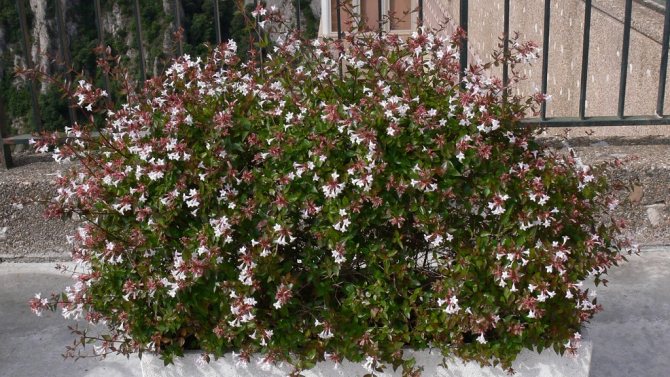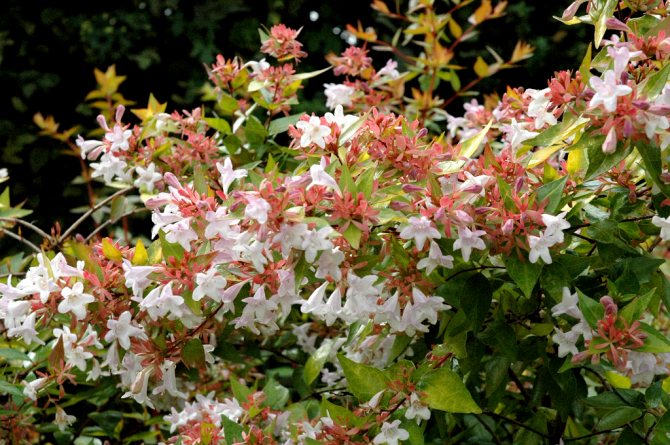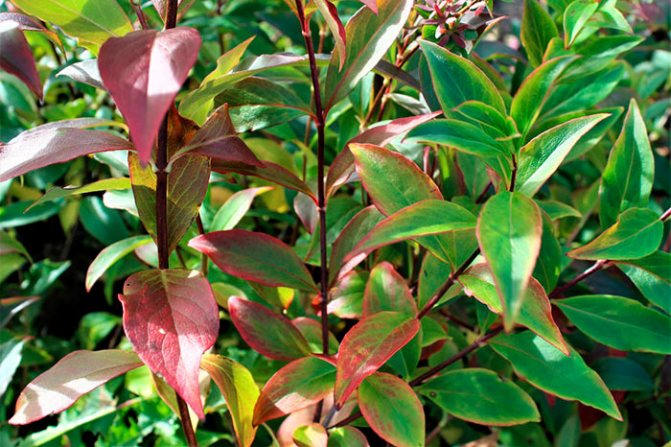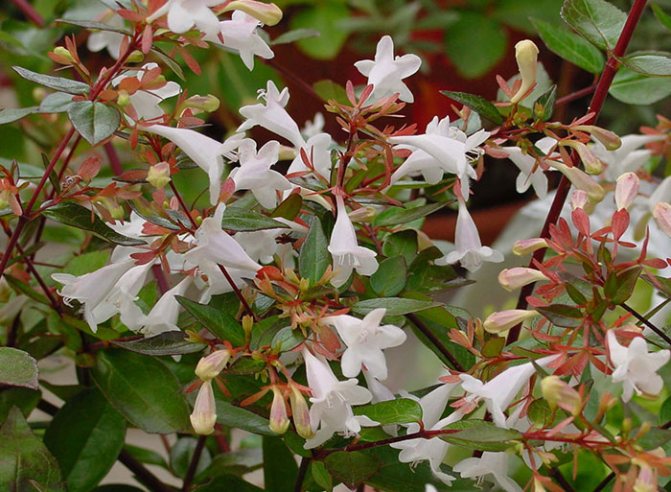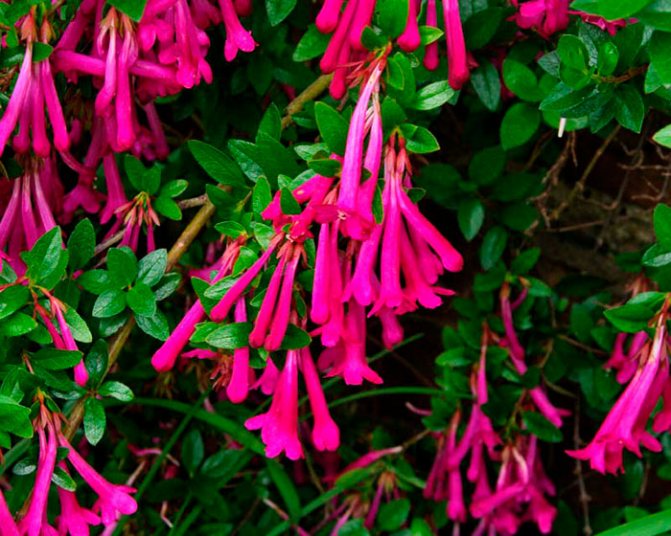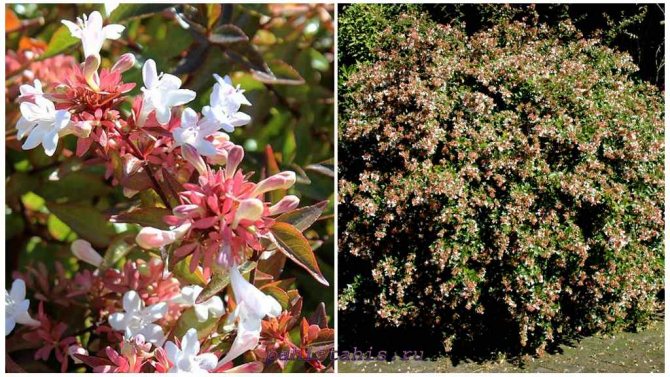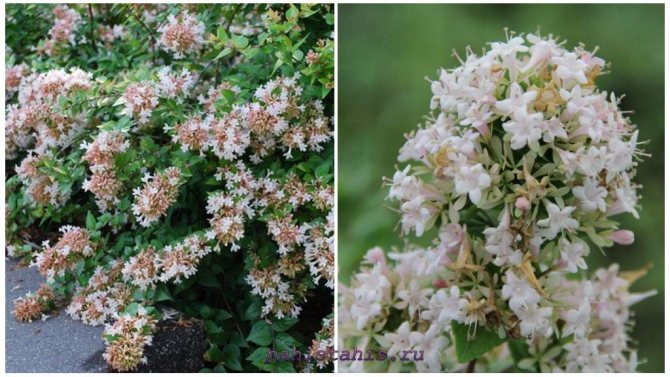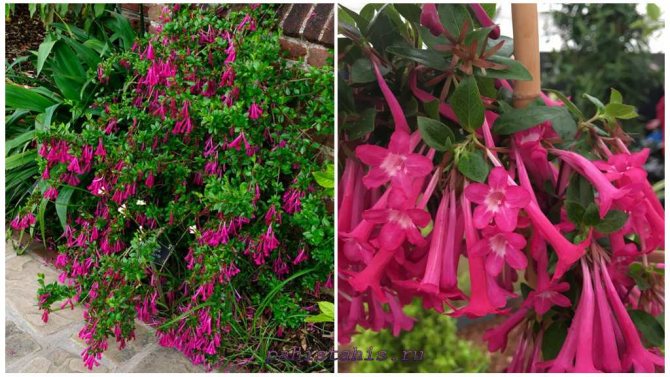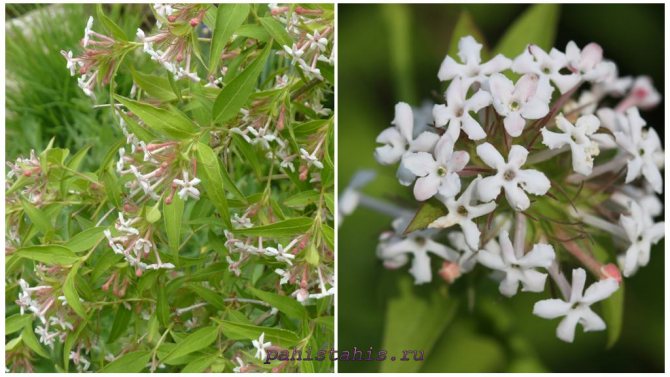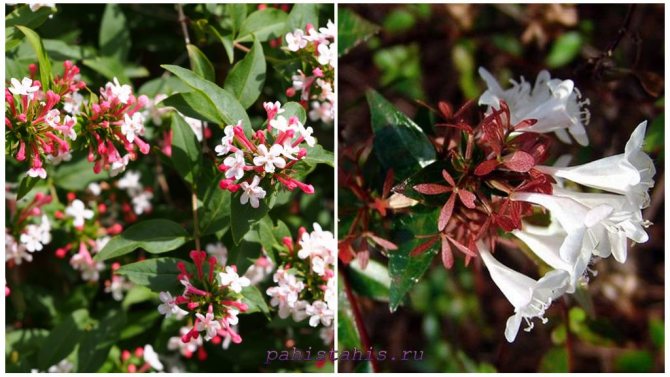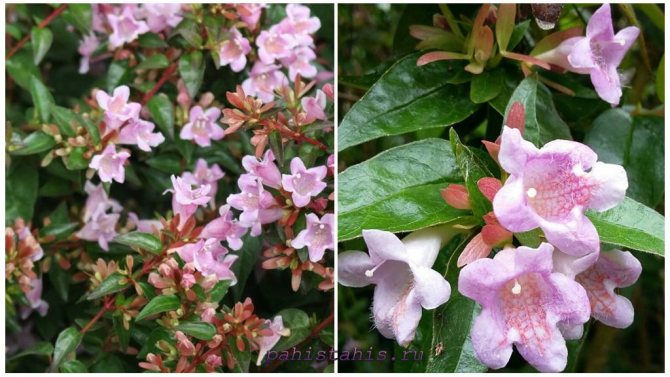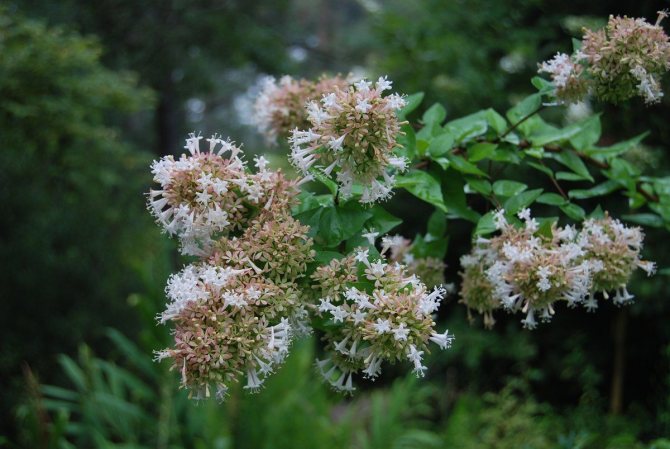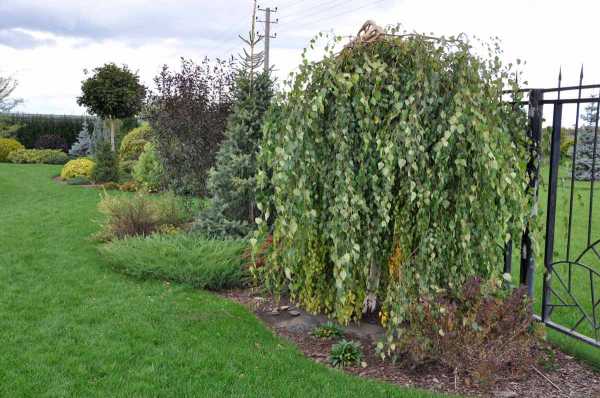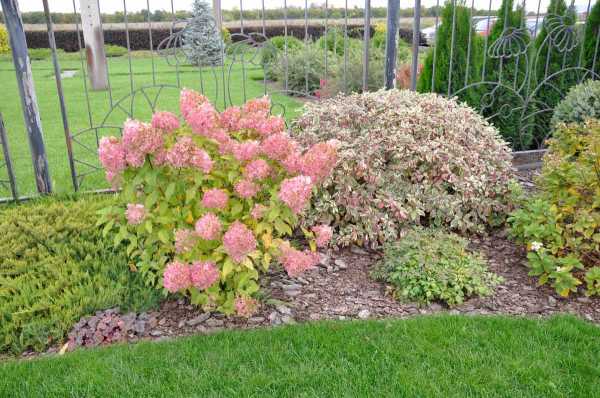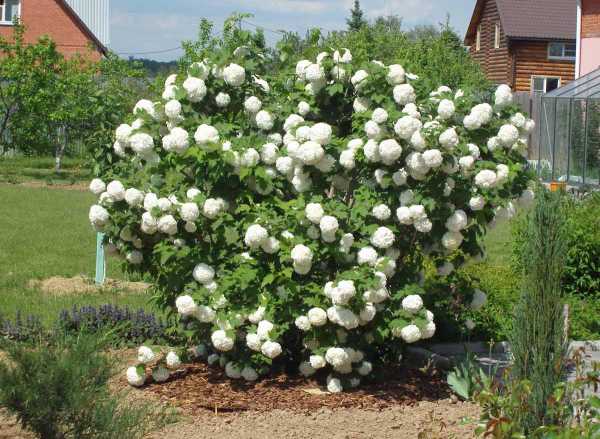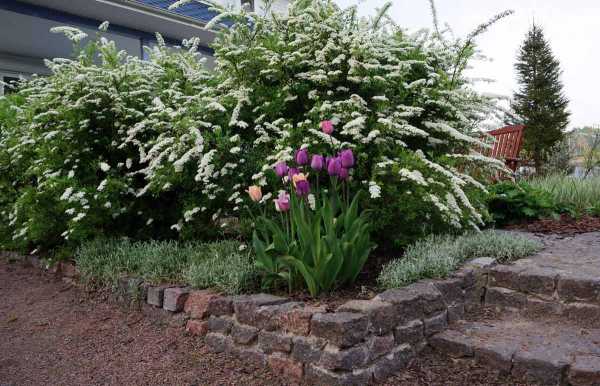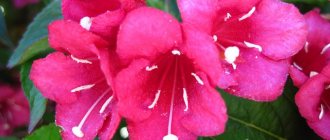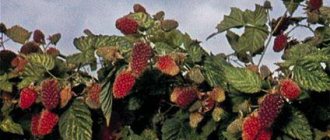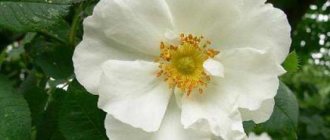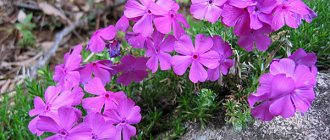The genus Abelia (Abelia) has about 30 different species of flowering shrubs and hybrids of the Honeysuckle family. In nature, representatives of the genus grow in East Asia (from Western Japan to the Himalayan mountains), Mexico and southern North America. Species growing in colder areas lose some or all of their leaves in winter, while subtropical plants are evergreen.
The ornamental Abelia shrub was named after Dr. Clark Abel, a naturalist, explorer and surgeon who was appointed chief medical officer of the Chinese embassy in 1816-1817.
Unfortunately, all specimens of the culture and seeds that the scientist collected during the service were lost in a shipwreck on his return to England. Scottish botanist Robert Fortuna did not bring the first specimens of the Chinese species to Europe until 1844.
Description of abelia
The plant is a dense, compact shrub with a height of 50 cm to 1.5 meters, depending on the species. Branches are thin, drooping in tall forms.
A characteristic feature of the culture are fragrant tubular flowers, collected in paniculate inflorescences at the tips of the shoots. Flowering is abundant and long, begins in late May, early June and can last almost until autumn.
The color of the flowers ranges from white to purple-pink. After flowering, bright red sepals remain on the shoots of some species, which effectively contrast with the green foliage.
Abelia Korean: best views
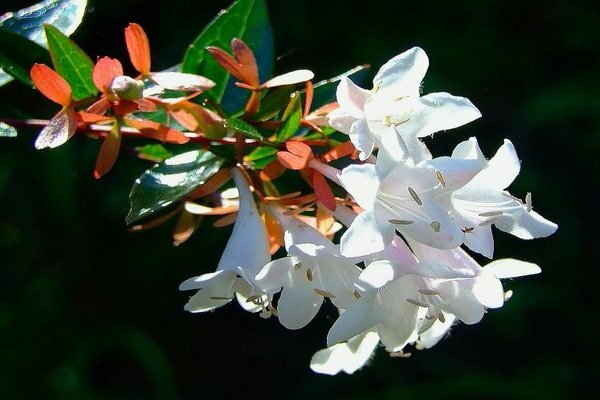
30 types of Abelia are distributed throughout the continents of our planet, of course, excluding the eternally cold ones. The first species were discovered and characterized by Clark Abel.
Today the leading places are occupied by:
1. Floribunda was brought to our regions from Mexico, where this species was actually discovered. In translation, the name sounds like "abundantly flowering" which fully characterizes the shrub, a huge number of large flowers colors the plant pink. In combination with the brilliant light green foliage, Abelia will delight your eyes throughout the flowering period.
2. Large-flowered Abelia is a hybrid. It blooms with rather large flowers, each with five petals, of a soft bed pink color with a not bright aroma. Plant height varies from one and a half to two meters. The downside can be considered the possibility of growing only in the southern regions, since it is very susceptible to cold weather and temperatures below minus 12 degrees are not viable for it.
Large-flowered and profusely flowering Abelia are the only two species with large flowers.
3. Chinese. The flowers are white with a faded pink base and are located on branches slightly lowered to the bottom.
4. Tricolor. Quite a large representative of its kind, it can reach 4 meters in height. The flowers are tubular, the color goes from crimson to bed-pink.
5. Korean Abelia has a long flowering period. The branches are dense and close to each other.
6. Abelia Schumann pleases the gaze of a gardener from June to September. In comparison with other species, the number of flowers is not large, but does not make it less attractive, and the delicate lilac color goes well with other plants.
Garden species, hybrids and varieties of abelia
Abelia mosanensis with a stunning perfumery scent of flowers from a delicate mixture of lilac, hyacinth and jasmine. The flowers are white, as if waxy, bloom in late spring. Flowering lasts until early June. A hardy species, resistant to frost up to minus 15 ̊С.


Chinese Abelia (Abelia chinensis) produces more flowers in inflorescences than other species. The dark green leaves have a slight maroon hue.
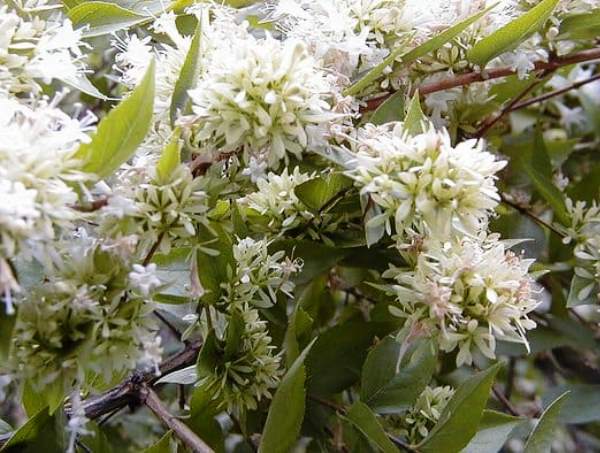

Abelia Korean (Abelia biflora). The most winter-hardy tall species that does not require shelter.
Abelia grandiflora or grandiflora. It is a hybrid of Abelia chinensis and Abelia uniflora. It is the most common hybrid form in cultivation, with dozens of great varieties of varying sizes. The leaves are glossy, dark green turning bronze-red in winter.


In addition to fragrant inflorescences, the large-flowered abelia of the variegated group amazes with a variety of hybrid decorative deciduous forms with a wide variety of variegated foliage colors.
Lavender Mist is a compact shrub with bluish foliage that turns purple-red in autumn and deep purple in winter. The flowers are lavender and white, characterized by two flowering periods in June and August.
Abelia "Kaleidoscope" is the brightest, most colorful, evergreen, undersized and compact variety. Grows well in moist, well-drained, slightly acidic soil. Group plantings create a spectacular kaleidoscope of colors in the garden.
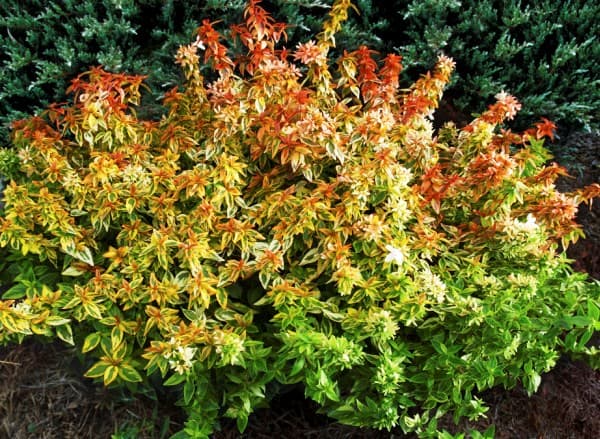

New variety "Confetti" up to a meter high. Regular formative pruning gives it a rounded shape. Leaves are dark green with creamy, white and pink tints, often with yellow edges. The flowers are pink.


"Little Richard", a profusely flowering dwarf, round and dense shrub. The green leaves turn orange-pink in autumn.
"Francis Mason" is another dwarf variegated variety with yellow-green foliage.
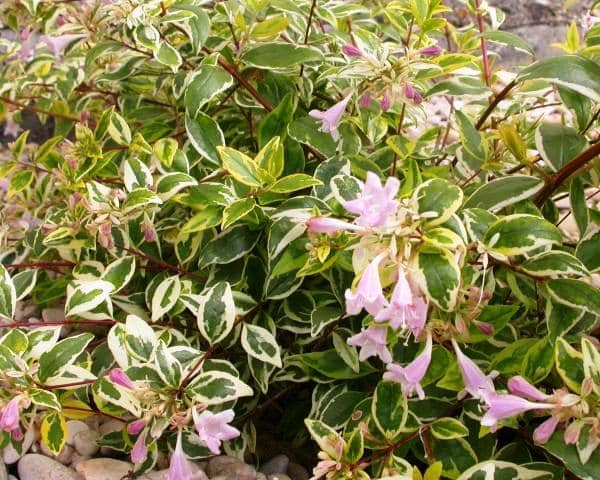

"Mardi Gras", the size of the variegated variety is 50-80 cm in height and a meter in width. The leaves are colored pink, green and white. After frost, the bush becomes copper in color. The flowers are fragrant, pink.
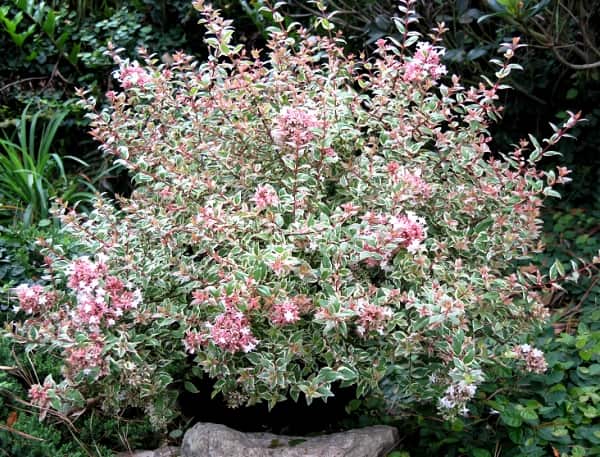

A group of varieties with golden foliage has also been bred: "Keats gold", "Super Gold", "Little Gold" and others.
Abelia Korean: description
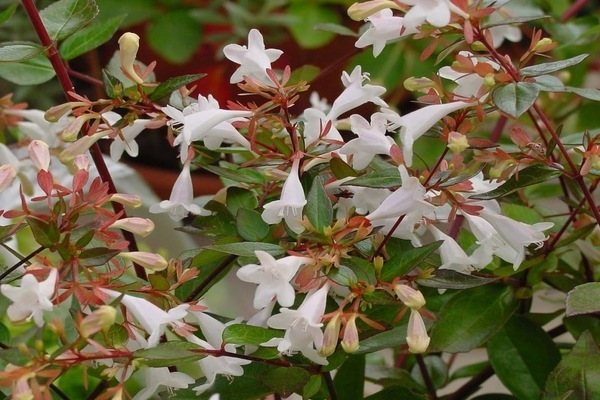

Abelia Korean can be safely called the first in its kind in terms of ease of care and resistance to diseases and weather conditions.
1.Shrub of medium size, from one and a half to 2.5 m in height. In accordance with the process of growth and development, it is classified as slow-growing.
2. Wild grows in mixed forests or rocky areas.
3.The crown is dense, from the base of the branches stretch upwards, then they descend to the ground.
4. Lanceolate leaves are located two at each node. In the autumn, the foliage changes its color to burgundy-orange.
5. The flowers are 1 cm in diameter, the color is pale pink and the petals are slightly bent in opposite directions.
6. Differs in a long flowering period for ornamental shrubs from the last weeks of May to early October.
7. Strong and rich aroma is characteristic.
8. Fruits are small and elongated, no more than 1 cm in size. Fruits from August to September.
9. Not divided into varieties; only wild-growing is grown in the gardens.
Abelia shrub, open field care
The ornamental Abelia shrub is easy to care for and resistant to short-term drought, however, newly planted young plants should be watered regularly throughout the growing season. The soil should dry out about 7 cm deep between waterings.
Adult plants need additional watering only during a hot and dry long period, and the usual irrigation regime is once every 2 weeks.
For planting abelia, choose a sunny, sheltered place from the wind.Can also be planted in light partial shade. The shrub grows best on fertile, permeable, slightly acidic and moderately moist soils. Stagnant water and dampness can cause root rot and other fungal diseases.


Variety "Lemons And Lime"
Before planting, the soil from the seedling pit is mixed with compost and one part of peat. Water the seedling well and cut off all shoots by about 15 cm.
To maintain the acidity of the soil, maintain moisture and suppress the growth of weeds, it is recommended to lay a layer of pine bark mulch around the plantings.
Read on: Soil mulching function and types of garden mulches
In spring and autumn, compost is brought into the ground and dug up. The bush responds well to fertilizing with fertilizers intended for hydrangeas or azaleas 2-3 times per season. For the winter, shrubs sensitive to frost are insulated with spruce branches or agrofibre.
Pruning
Abelia care includes pruning, which is carried out in early spring. The bush blooms on new shoots, so in the spring they shorten the old branches, thin out the too thickened bush, remove dry and damaged shoots. To form a compact crown, the tops of the branches are cut off by 5-10 cm in early spring or after flowering.
Old plantings can be rejuvenated by radically shortening the shoots in early March. The entire bush is cut off, leaving 50-25 cm from the soil surface. After cutting, the shrub will begin to develop new shoots.
Abelia: disease
Abelia, like all other asthenia, is often attacked by pests and sometimes gets sick.
Aphids on abelia
Aphids often cause significant damage to young abelia shrubs. One of the most harmless ways to fight aphids is green potassium soap, 20 g of which is diluted in 1 liter of water and the plant is washed, covering the pot with earth with a foil. Laundry soap is also harmful to aphids.
A good effect is obtained by the use of synthetic pyrethroids, which include a large group of drugs. The most common are decis, carat. The dosage and route of administration are usually indicated on the package. The advantage of pyrethroids is low toxicity.
Mob on abelia
On the sugary abelia secretions that cover the leaves, moles often develop.
Insects are thoroughly cleaned from branches, leaves and stems with hard brushes and plants are treated with Vertimek solution every 5-6 days for 3 weeks.
spider mites and thrips
The plant is often affected by spider mites and thrips. To combat the pest, the drugs Vertimek, Nurell-D, Mavrik are used.
A good remedy for spider mites is a decoction of cyclamen tubers. The active substance of cyclamen is saponin. To prepare the broth, 50 g of tubers are dipped in 0.5 liters of water and boiled until they are boiled. The liquid is filtered through cheesecloth, then the trunk, twigs and leaves affected by the mite are smeared with a brush. After 5-6 days, the treatment is repeated, after which all pests disappear.
A solution of Persian chamomile and green soap works: 4 g of green soap and 5 g of chamomile infusion are needed per liter of water. Plants are sprayed with this liquid, after 24 hours they are washed with warm water. It is necessary to fight the tick until it is finally destroyed.
Abelia in the garden and at home gives flower growers a lot of joy. With a little effort, a collection of plants can be supplemented with beautiful abelia, which will delight every day with its flowering.
Reproduction
There are three ways to propagate a shrub:
- With the help of cuttings. This breeding method is the most common. The stalk is rooted in the spring after pruning the plant and at a temperature of at least 20 degrees.
- Seeds. They are sown in January, when their germination is greatest. The first flowers on a young bush can be seen in the same year.
- By separating the root growth from the bush, which every year arises directly near the root.
Abelia large-flowered loves its place and requires transplantation only in exceptional cases.
The plant has sufficient branching, so it does not need pruning. You can cut off only those branches that seem superfluous or form the top, but after flowering is complete. Dry leaves and branches should be removed periodically.
Basically, the shrub is grown in greenhouses to further decorate various public spaces. In summer cottages, gardeners have a widespread variety of Abelia kaleidoscope, which is unpretentious and grows well in very harsh conditions.
Plant application
This plant is actively used both for single planting and for group decoration of rooms, premises, borders. When using the ampola design, they are grown in pots, the contemplation of an outstretched bush and drooping branches is formed. When grown in temperate climates, the plant has a great outdoor winter. However, planting should be done in a sufficiently deep manner. There are varieties when cultivation takes place in hanging baskets. As a result, to preserve the elegance of the plant, prune selectively, only outdated and weaker shoots. Any plant becomes more sluggish with age, the lower part of the stems is bare. You just need to replace the ancient bush with a younger plant. You can also say that there are varieties that can calmly overwinter, covered with simple spruce branches and fallen leaves. Such varieties grow mainly in the middle lane.
Problems in plant cultivation
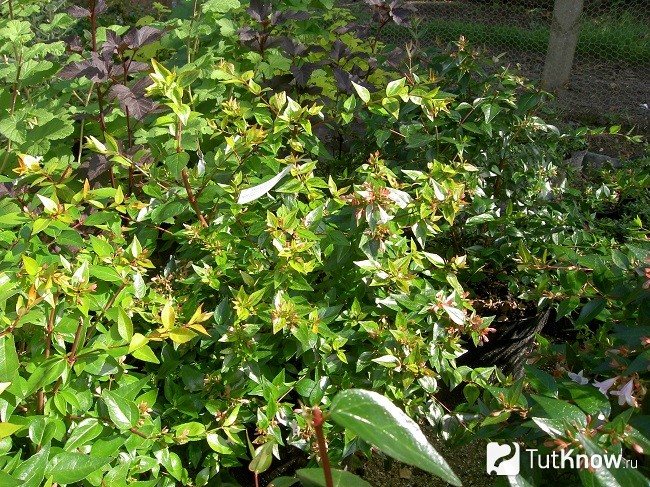

Aphids are most harmful to the plant. When damaged by this pest, a sugary sticky coating appears on the leaf plates, which, if no action is taken, will turn black - a sooty fungus will develop (fungal disease). It is also possible, in case of violation of the conditions of detention, that abelia is affected by spider mites and thrips. In the presence of these pests, needle punctures of the surface are visible on the back side of the leaf blades (the pest drinks the vital juice of the leaves), and then the same sticky bloom or a thin cobweb appears, which wraps all the leaves and internodes of the plant.
If abelia is affected by scale insects or mealybugs, then brown-brown or gray-brown dots (pest eggs) form on the back of the leaf plates, and a sticky bloom covers the surface of the foliage. The mealybug is immediately recognizable by the discharge in the form of lumps of cotton wool, which are visible in the internodes and leaves.
With any damage, the leaves turn yellow, they are deformed and reset, flower buds do not open and fly around, and the whole plant slows down in growth.
Often, experienced flower growers make a solution from cyclamen tubers, it also helps to remove harmful insects and remove plaque, this drug does not harm the plant as much as chemicals. But re-processing must be carried out already on the 5-6th day. Usually, when damaged by pests, wipe the leaves and shoots with a soap, oil or alcohol solution. They are prepared as follows:
- to create a soap product, 10–30 g is dissolved in a bucket of water. grated laundry soap (or washing powder), then wait a few hours, the liquid is filtered and ready for use;
- for oil in 1 liter of water, it is necessary to dissolve 2-3 drops of rosemary essential oil;
- an alcoholic tincture of echinacea or calendula is purchased at the pharmacy.
The agent is applied to a cotton pad, and insects, eggs and their waste products (plaque) are carefully removed from each leaf and branch. Indoors, you can spray the very place where the pot with the plant is located.
If methods that do not contain "aggressive" chemistry do not give a positive result, then insecticide treatment (such as "Aktara", "Aktellika" or "Confidor") will be required.
Abelia: varieties
Schumann's variety - a bush capable of reaching a height of up to 2 meters, flowers are tubular in shape, endowed with a lilac color with a pink tint. Blooms in early June and until October pleases with abundant flowering. The buds of this bush have a very pronounced, pleasant aroma that bewitches everyone who is nearby. The fruit of the variety is small enough, leathery in composition and contains only one seed;


Grandiflora, or simply - Abelia large-flowered, is a sprawling, multi-stemmed, round-shaped shrub. The branches bend very gracefully. The leaves are ovoid, opposite, dark green in color. The inflorescences resemble bells or the tubular form of flowers, painted white with a pink tint. From the beginning of May to the last days of September, there is a continuous, abundant flowering. The bush can grow up to 180 centimeters. It is at the top of the shoot that a panicle-inflorescence is formed, consisting of white, small, very fragrant flowers;
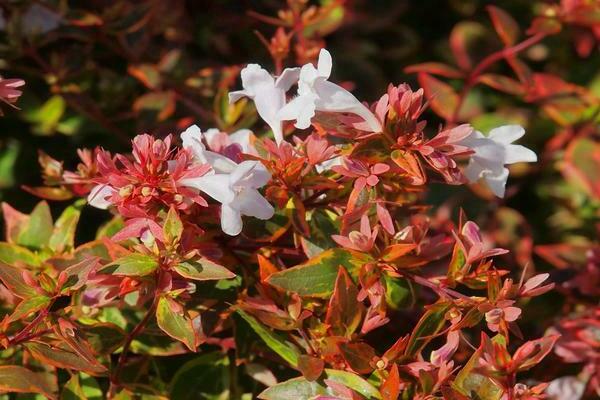

Korean Abelia - in the wild, it grows preferably in rocky areas, in the vicinity of other shrubs in the forests of Korea. The period from germination to a full-fledged bush is quite long, slow, but the bush can grow up to 250 centimeters. The shape of the leaves is elongated, ovoid, does not exceed 6 cm in size and up to 35 mm in width. Tubular inflorescences, each flower is very small, no more than 2 centimeters. The flowering period is not as long as that of congeners, only a month, from the beginning of June;
Chinese Abelia is a deciduous shrub, attractively multi-stemmed, with a long flowering. The main period of active color is from mid-July to almost September inclusive. On young shoots, though a short, but very dense pubescence is located. Mostly green leaves. At the edges, the leaf plates are slightly serrated. Flowers of white color and attractive aroma are tubular in shape, bracts are endowed with a pink tint, small flowers are collected in an umbrella inflorescence. This variety is distinguished by the most abundant flowering, sometimes the branches even bent downward under the resulting weight of flowers;
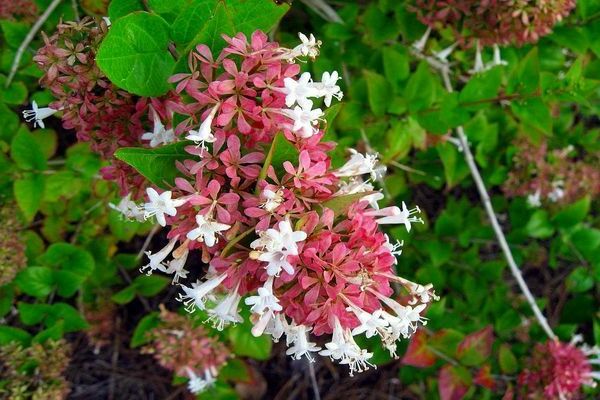

The Kaleidoscope variety is a relatively recently bred Abelia species that belongs to large-flowered varieties. What is the varietal feature? A wide range of color of the leaf cover prevails. Younger, spring leaves are painted in light green shades, gradually the color changes to a more pronounced, darker one, in the summer season the shade of the foliage becomes yellow, with a golden tint. In the fall, the leaves turn into a fairly bright, purple outfit. In the center, the color of the leaf is always darker than the main tone, in particular brown. White, slightly pink flowers of a very large size and a fascinating aroma;
Shield abelia. The bush grows small. Lush crown, slightly rounded, forms many thin and rather flexible shoots. The leaves are dark, green in color, with jagged edges. White or pink inflorescences, wonderful aroma;
Edward Gucer's cultivar - the varietal feature is the duration of flowering and the bright color of the flowers. The inflorescences are mostly pink, but you can also observe the presence of burgundy tones. Young foliage is colored brown with a copper sheen. According to the degree of maturity, it turns into a dark green color, which, in turn, turns into bronze tones for the autumn period;
Mosan Abelia - in this variety, flowering begins relatively early. The aroma has jasmine notes, the color of the flowers is pink, green foliage. Another feature of this variety is good frost resistance.
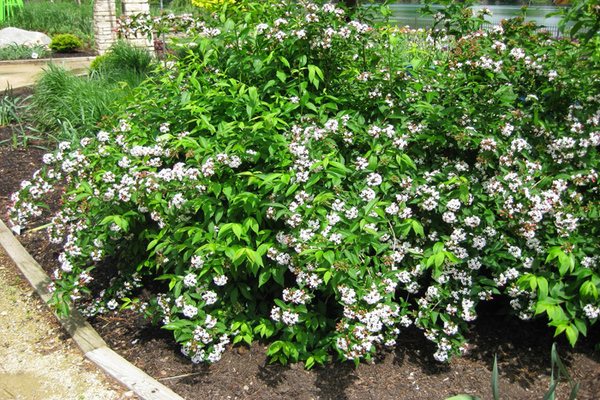

Planting and caring for abelia at home
Growing and reproducing abelia does not require much knowledge in the field of gardening, which is why we can recommend it to novice amateur gardeners. In addition, Abelia is not whimsical to care for.The flower has an extraordinary, magical aroma and many are planted for this very purpose. By the way, the plant blooms very profusely and for a long time, which means that your garden will receive a worthy decoration for a long time. Growing abelia at home requires compliance with certain temperature standards: for example, in the summer, the temperature in the room where the flower is kept and growing should not be lower than 22 degrees, in winter the minimum permissible threshold is 10 degrees. Direct sunlight is preferable, but diffused sunlight will also work. Caring for Abelia at home is reduced to the implementation of simple agrotechnical measures, including timely watering and the introduction of complexes of mineral fertilizers with a predominance of phosphorus and potassium. Do not allow waterlogging and drying out of the earthen coma. The plant should be watered sparingly, but at the same time, in no case do not allow the soil to dry out. In winter, the amount of watering should be reduced.
On warm and hot days, Abelia requires much more moisture, so it is advisable to periodically spray it with cold water.
Feeding the flower is carried out throughout the year, but in winter the fertilization procedure must be stopped. Proper care of abelia at home guarantees long-lasting abundant flowering. Growing abelia indoors, as a rule, is advised on the windowsills, near the window facing the south side. In winter, the flower may not have enough light, so it is recommended to add artificial light to natural lighting - for example, fluorescent lamps are good. Planting abelia requires certain skills, since it reproduces mainly by cuttings, but only in the spring (after pruning). The procedure should be carried out at a temperature of at least 20 degrees. You can also plant the seeds of the plant, but their germination capacity is much less. Planting abelia with seeds is carried out in winter (in January), since it is during this period that the seeds grow the fastest. And already in the same year you can see the first flowers on the young shoot. There is another way to reproduce and plant abelia - with the help of root shoots. Each year, shoots form around the root, which you can carefully remove and transplant into new soil. During the growing season, do not forget that Abelia does not tolerate drafts - therefore, it is better to protect the flower from the wind during airing or remove it to another place.
It is recommended to transplant a flower only when necessary, and so for a long time it can live and exist perfectly in one place. Abelia branches very well, therefore, unlike other species, it does not require additional pruning. In the process of growth and development, you can remove dry and damaged branches, as well as those that are ugly, in your opinion. Gardeners say that if you wish, you can periodically adjust the top, but it is recommended to do this only after flowering.
Planting and breeding


OLYMPUS DIGITAL CAMERA
In 90% of cases, Abelia loves warmth, while Korean Abelia is an exception to the rule, calmly tolerates light frosts down to minus 8 degrees.
The ideal season for planting is spring.
The shrub has three methods of propagation: seed, cuttings and root suckers. In the first version, the seedlings will break through in one or two months, the first flowering can be observed after 3 years. The second option is less preferable due to its low survival rate, and the third is the most effective.
Read also: Heather mix at home
In the choice of soil for planting, preference is given to loamy and sandy loam. Stagnant water should be avoided. There is no priority in choosing a shady or sunny side.


Abelia Korean in care is not very whimsical, here are the main recommendations:
1. Fertilize the shrub three times: with a vein, during the budding period and in the fall.Fertilizers are phosphorus-potassium, mineral and superphosphate, respectively.
2. It does not need frequent watering, but if the soil under the plant is dry, it must be loosened and moistened.
3. The main threat among pests is aphids, generally resistant to diseases.
4.To increase branching, pruning is performed.
5. Young plants are covered for the winter.
Abelia Korean perfectly overcame a single planting or in a composition, create alleys or decorate places for rest. The plant will fill your garden with a wonderful scent and delicate flowers.
| Name | Abelia coreana |
| Family | Honeysuckle (Caprifoliaceae) |
Origin:
Far East, northeastern China, northern part of the Korea Peninsula
Habitat:
on stony and rocky slopes in thickets of bushes, in mixed forests, on open slopes
Sizes and forms of growth:
life form:
- in nature 1-2.5 m;
- in Moscow - 3 m
crown diameter:
in Moscow - more than 2 m
crown shape:
broadly ovate, spreading, densely branched, with angularly diverging branches
root system:
gives numerous root suckers
Growth rate:
in the first 3 years it grows slowly, then the growth rate is average
The soil:
mechanical composition of the soil:
Planting and reproduction:
optimal landing dates:
breeding methods:
features of seed reproduction:
- seeds are sown in spring, shoots appear in 1-2 months;
- seedlings usually bloom in the 3rd year
vegetative propagation:
- propagates by green and mature cuttings (rooting rate 16% when treated with Kornevin);
- most easily propagated by root suckers
Watering:
in dry periods it needs watering
Top dressing:
responsive to summer feeding with organic and mineral fertilizers with microelements
Cropping:
in the spring, sanitary pruning of damaged shoots is carried out, at the end of summer - rejuvenating pruning to enhance branching
A haircut:
tolerates small haircuts well
Winter hardiness:
main view:
winter hardiness zone
Shelter for the winter:
desirable for young plants
Decorativeness:
Decorative season:
The peak of decorativeness:
during flowering and fruiting periods
Decorative properties:
Trunk (bark coloration):
trunks with brownish-gray bark, cracking along
Branches (bark color, shape):
shoots are reddish brown, glabrous
Leaves:
opposite, oblong-ovate or broadly lanceolate, 2.5-6.5 (8) cm long and 1-3.5 (4) cm wide, with a rounded or wedge-shaped base, in the upper part they are coarse or serrate, less often whole-edged, with ciliate edge, hairy from above, pubescent from below along the veins, on petioles 2-7 mm long, widened and fused at the base, enclosing the buds
Summer color of leaves (needles):
Flowering time:
- June;
- in Moscow blooms annually since the last decade of May, almost a month
Color spectrum:
Flowers:
with a narrow tubular calyx with 4 bent obovate ciliated lobes 8-12 mm long and 2-3.5 mm wide, corolla tubular, 12-15 mm long, with a 4-lobed limb 7-8 mm in diameter, straight tube 3.5- 4 mm wide, above the base in front with a saccular swelling, on the inside and at the top of the hairy, with a pleasant aroma
Inflorescences:
flowers are arranged in 2 at the ends of short leafy twigs, on pedicels 3-6 mm long
Read also: How to make sea buckthorn tea from frozen berries
Fruit:
about 1 cm long, leathery, oblong, with 4 longitudinal ribs, with 1 oblong, tapering from above, flattened seed
Fruiting time:
- Aug. Sept;
- in Moscow, the fruits ripen at the very end of July
Features:
urban resilience
Planting type:
Planting type:
more suitable for the south of Russia, in the middle lane it needs a warm, protected place
The genus Abelia (Abelia) has about 30 different species of flowering shrubs and hybrids of the Honeysuckle family.In nature, representatives of the genus grow in East Asia (from Western Japan to the Himalayan mountains), Mexico and southern North America. Species growing in colder areas lose some or all of their leaves in winter, while subtropical plants are evergreen.
The ornamental Abelia shrub was named after Dr. Clark Abel, a naturalist, explorer and surgeon who was appointed chief medical officer of the Chinese embassy in 1816-1817.
Unfortunately, all specimens of the culture and seeds that the scientist collected during the service were lost in a shipwreck on his return to England. Scottish botanist Robert Fortune did not bring the first specimens of the Chinese species to Europe until 1844.
Growing
To grow a shrub in the garden, it is necessary to carefully select suitable conditions for its existence. The planting of bushes is carried out either in the autumn period or in early spring, when the night frosts have already stopped:
Important! Abelia, due to the large volume of the bush, combined with the fragility of the branches, categorically does not tolerate drafts, so the site must be ventilated, but protected from intense air currents that can damage the delicate plant.
- First of all, you need to choose the right place, since Abelia loves light very much, but does not tolerate direct sunlight very well.
- The plant belongs to heat-loving crops, therefore it tolerates hot weather calmly, provided that the irrigation regime is not violated. Winter cold is not the most comfortable time for him. Up to 10 degrees Celsius, Abelia retains foliage, if there is a sharp drop in temperature, it drops foliage.
- The plant is hygrophilous, but it is not worth overfilling it in order to avoid rotting of the root system.
- The soil for the plant should be based on turf, peat and sand, very nutritious and breathable, with good drainage properties. The hole for planting a bush should be slightly larger than the earthen lump in which the plant to be transplanted is located, drainage stones are poured onto the bottom of the hole, this can be expanded clay, crushed brick or other similar materials that can perform the function of drainage.
Description of the plant
Abelia (Abélia) is a deciduous or evergreen (semi-evergreen) slowly growing shrub with a height and diameter usually from one and a half to two and a half meters (sometimes up to six meters). The genus is named after Clark Abel (1780-1826), an English doctor, botanist and zoologist, researcher of flora and fauna in China, India, Indonesia.
The leaves of the plant are opposite, paired, oval, pointed, usually dark green, shiny. Flowers are tubular (funnel-shaped, bell-shaped), five-lobed, fragrant. Usually small; the largest flowers - about 5 cm in diameter - in the Abelia floribunda species. There are five petals, they are usually white or pink, sometimes purple.
This plant, mesmerizing with its lush color, belongs to the Linnaeaceae subfamily of the Caprifoliaceae family. The genus is named after Clark Abel, an English doctor, botanist and zoologist, researcher of flora and fauna in China and India.
Abelia in the garden
Abelia is one of the most popular garden plants. Abelia in the garden is luxurious, and blooms from June to September-October in the summer. There are both thermophilic species and quite frost-resistant species.
Conditions
Abelia, when it comes to indoor plants, likes:
- Abundant diffused light. But direct sun is contraindicated for the plant. The best place in the apartment is by the south or southeast window, shaded with tulle curtains.
- Room temperature, preferably not higher than 25 C, semi-evergreen species require a decrease in temperature from mid-autumn to 10-15.
- High humidity. She will enjoy daily spraying with warm water.
- Abundant regular watering.Care should be taken that the earth does not dry out, this applies even to the cold season.
- Top dressing. Enough complex fertilizer for indoor flowering plants during the period of active flowering and growth - from March to September. Top dressing is carried out every two weeks.
- Spacious pots.
What the plant dislikes:
- Heat.
- Drafts. The plant is extremely sensitive to them, even in summer.
What soil to plant?
The mixture is prepared from:
- Sand (1 part)
- Humus (2 parts)
- Purchased peat (2 parts),
- Sod soil (2 parts).
Transplant - weightless, as needed. Young plants are replanted annually, perhaps even twice a year.
Pruning
It will increase the decorativeness of Abelia and allow you to pacify the exuberant growth, to which the plant is very prone to indoor conditions. Pruning is carried out after flowering, around the end of winter. Prune mercilessly, shortening the stems to the maximum length - this stimulates tillering.
Outcome
As a result, we will emphasize several secrets of successful abelia cultivation:
- The temperature in summer does not exceed +25 degrees, in winter it is not lower than +14;
- Regarding lighting, sunlight should be enough, but without direct rays;
- It is good to moisturize the watering process and the humidity in the substrate, especially during the growing season. In the spring, we take into account the temperature in the growing room;
- Pruning should be very minimal, even just sanitary, and only in the spring;
- The growing soil is a little sour, if not, then add coniferous composition;
- It is necessary to feed abelia during the active growing season, organic matter or minerals;
- It can be propagated in spring and summer, by cuttings or using seed.
So. A little effort and you become the owner of a beautiful, unpretentious plant.
Recommendations for self-breeding abelia


The plant can be propagated using seed material, cuttings and root shoots.
With the help of seeds, Abelia multiplies very reluctantly, since their germination is very low. Seeds must be sown in the month of January in seedling boxes. The substrate is selected light (sand or peat-sand mixture). After disembarkation, the container is wrapped in plastic wrap or placed under glass. You will need to periodically ventilate and moisten the soil. Seedlings grow very quickly, and as soon as a pair of true leaves appear on the sprouts, you can dive (transplant in separate containers) with the same substrate as for adult specimens. As soon as the height of the plants reaches 15–20 cm, another transplant is carried out into pots with a large diameter or onto a garden plot.
When pruning, you can select suitable branches for rooting, they must be from the apical shoots. Spring time is suitable for such rooting. The length of the cutting should not be less than 10 cm. The cuttings are planted in moist soil (sand, peat, perlite, or a mixture of these components). During rooting, it will be necessary to maintain heat within 20-25 degrees. After 2-3 weeks, the plants can be transplanted into a suitable abelia substrate and into a large container. These cuttings grow quickly and from them you can form a beautiful bush that will bloom this summer.
Abelia's root shoots grow annually next to the roots of the bush. Young plants are carefully separated from the mother bush and planted in the ground in a pot or in a garden.
Abelia reproduction
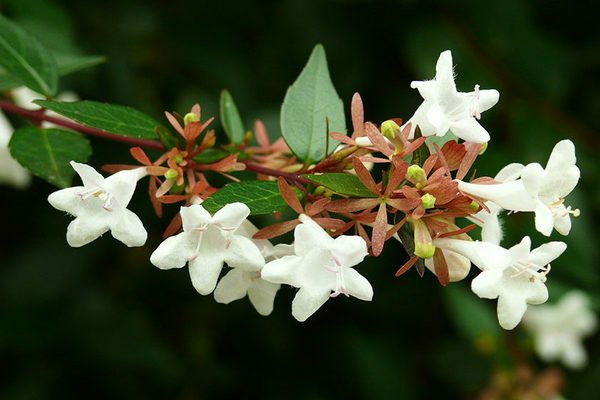

The main direction of reproduction is cuttings, both young and more mature shoots are suitable for such a process, about 15 cm long, the whole process takes place in the summer. The choice is stopped both in the first month and in the last. The most optimal temperature for this does not exceed +20, but it should not drop more than +10 degrees. Young shoots must be covered with a glass device, just glass.In doing so, you create even moisture. Place the container with a young seedling in a warm place, where there is no direct sunlight. The engraftment process itself lasts up to about 5 weeks, but not every stalk is able to take root. It very often happens that the plant forms root suckers, the separation of such is possible when the latter have already developed an independent root system. The offspring should be deposited in a separate container.
When time does not rush you and you have enough patience to observe the most complete breeding cycle, planting with seed is possible. Sow seeds in early spring, the soil needs to be loose, nutritious enough and moisture should be adequate. Seeds should only be used fresh and of good quality. After the appearance of the first leaves, make a pick. Seed-propagated plants have the ability to flower in the first season after planting.
Pests and diseases
The plant is appetizing enough for the most common indoor pests:
- Thrips,
- Aphid,
- Spider mite,
- Shield,
- Mealybug.
It is worth noting, however, that these pests affect weakened plants. So the best prevention is proper care.
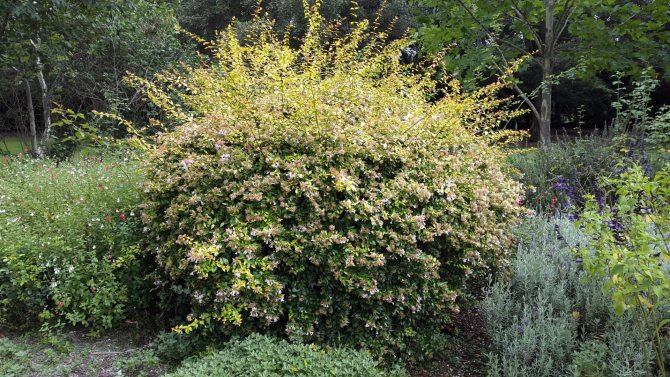

Abelia grandiflora francis mason
Abelia - ornamental shrub
Abelia is a deciduous or evergreen, slowly growing ornamental shrub with a height of 1.5-2.5 m, under favorable growing conditions can reach a six-meter mark. Leaves are opposite, pointed at the ends, oval, dark green with shine, arranged in pairs.
The flowers are tubular, bell-shaped or funnel-shaped, small or medium-sized, five-lobed, have a pleasant and pronounced odor, and can be white, pink, purple or red. Flowering takes place from June to September, some species bloom until October. At the end of flowering, the leaves, densely located at the tips of the branches, fall off, and in their place are reddish or purple sepals, thanks to which the plants retain their decorative effect until the onset of stable frosts.
Growing conditions
Abelia is a light-loving plant, it prefers well-lit areas. In hot climates, it accepts slightly shaded areas, protected from northern winds. For growing crops, well-drained, moderately moist soils with a rich mineral composition are desirable.
Reproduction and planting
Abelia is propagated by seeds, green and lily cuttings, as well as by root shoots. Most often, gardeners use the third method. During the growing season, the shrub is able to give a large number of basal shoots, at the end of summer they are separated and planted in a permanent place.
Maintaining an optimal temperature is considered an important factor in the successful reproduction of abelia. If the temperature drops below 20C, young plants need to be covered. Abelia is rarely propagated by seeds and cuttings, this is due to the difficulties of rooting.
Planting seedlings of culture is carried out in early spring or autumn. The planting hole is prepared in advance, its depth should correspond to the size of the rhizome with the addition of 10-20 cm per drainage layer in the form of pebbles or rubble. The soil taken out of the pit is thoroughly mixed with organic and mineral fertilizers and river sand.
Part of the resulting substrate is poured into the pit, then the seedling is lowered, covered with the remaining mixture, tamped, watered and, if possible, mulched. When planting in autumn, seedlings need shelter for the winter, otherwise they may die from frost.
Care
Abelia is an undemanding plant, caring for it does not take much time and is subject to even a novice amateur gardener. The main tasks in plant care are formative and sanitary pruning.To maintain the aesthetic appearance of the shrub, old, diseased and damaged branches should be removed immediately after flowering. A special form of abelia can be given by cutting, however, this procedure will have to be carried out quite often, since the plants grow very quickly.
In dry periods, abelias need moderate irrigation; with a sufficient amount of natural precipitation, the culture does not require irrigation. Top dressing with mineral fertilizers is carried out in early spring. Since the abelia are cold-hardy, there is no need for shelter for the winter.
An equally important procedure for caring for plants is the fight against pests and diseases. Often abelia are attacked by aphids, the pest leaves a sugary discharge on the leaves, which subsequently leads to blackening. To combat diseases and illnesses, it is recommended to use approved insecticidal preparations.
Application
Many types of abelia are often used in landscape design, since plants are highly decorative not only during the flowering period, but also at the end of it. Abelias are used in single and group plantings, in the design of recreation areas. Varieties with gracefully curved branches and fragrant flowers are the perfect complement to gazebos, benches and other garden décor elements.
Abelia is often used as ampelous plants, they are grown in large flowerpots, which decorate porches, terraces and other rooms. Since the culture easily tolerates formative pruning, it is actively used in the design of hedges.
Care rules
In summer, Abelia large-flowered needs frequent and abundant watering, especially in the stage of active growth. In addition, it is recommended to regularly spray the leaves. This plant is seasonal and requires rest in the autumn-winter period. Therefore, with the end of summer, the frequency of watering is reduced to a minimum. To humidify the air, you can put a tray of water next to it. Shrubs that remain outside for the winter also stop watering immediately after the leaves fall.
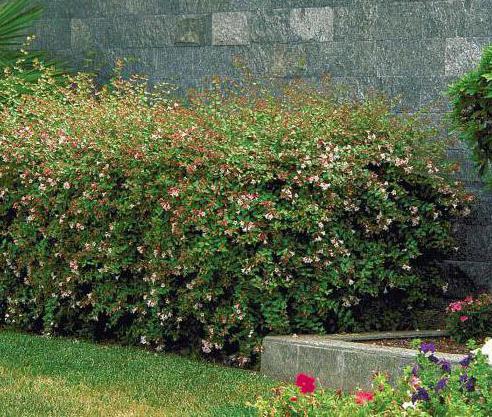

Good growth and abundant flowering will delight large-flowered Abelia every summer, which is cared for with all the requirements. One of them is the timely feeding of the plant. The shrub prefers substrates rich in organic matter, which means that in the spring it is necessary to add mullein, compost, humus or a solution of bird droppings to the soil. As soon as daylight hours begin to increase (in March-April), they begin to feed the abelia wintering indoors, while increasing the frequency of watering and the amplitude of the temperature regime. Organic and mineral fertilizers, alternating, are applied 2 times a month in the recommended concentration.
Abelia large-flowered, the description of which is given above, is growing at a fairly rapid pace. During the season, it can almost double in size. To give the crown a certain shape, the shoots are cut off. When growing an ampelous plant, pruning can be omitted. The right time for this procedure is the end of winter. To make the bush look more magnificent, pruning is performed immediately after flowering.
Abelia: soil and transplant
The soil for abelia should be well-drained, slightly acidic with a pH of 5.5 to 7.2. The alkaline environment of the earth can lead to a lack of nutrients, causing the leaves of the plant to turn yellow. Clayy, loamy fertile soils are suitable. For planting a plant, you can take sod land mixed with humus, deciduous soil and sand in equal proportions.
Attention!!!
Since the plant has strong growth, two transshipments are required per summer. Box specimens can be transplanted after two to three years.
Obelite care
Abelia does not require any particular care: drained rich soil, partial shade or sun and watering during drought are all she needs. Old shoots are removed immediately after flowering. In the dry period, a little moisture is required.Abelia is propagated by seeds, lignified and green cuttings, but the rooting rate of cuttings is low. The shrub produces good root growth and dense clumps. Abelia Korean does not need shelter for the winter.
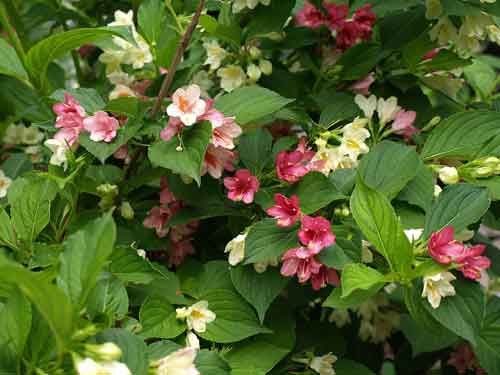

Plant species
Not all types of plants are suitable for growing at home. Consider several suitable flower varieties.
Abelia korean view
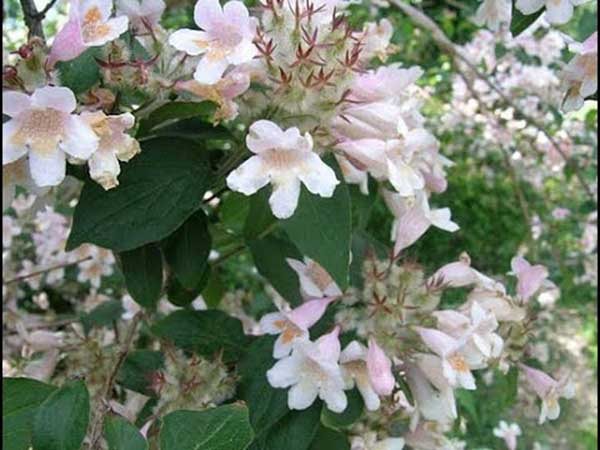

Abelia Korean blooms with white or pale pink flowers and has a strong fragrance that distinguishes it from other species. This is the most winter-hardy shrub variety compared to other varieties. The plant is not afraid of the sun's rays, so it can be taken out into the air from spring to late autumn without damage. Abelia Korean needs constant pruning, as it grows on last year's shoots. The leaves of the plant are dark in color, elongated. In autumn, they take on a beautiful orange or red hue.
Abelia Chinese
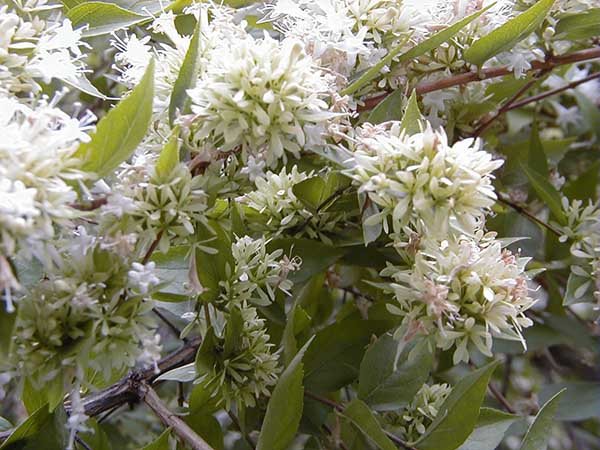

Abelia chinensis is a relatively low shrub, up to 2 m tall. The leaves are rather dark, oval with a pointed top. The flowers resemble a bell, usually white with reddish veins. Flowering begins in late spring to mid-autumn. Has a pleasant flower scent. After the plant fades, bright red sepals and bronze leaves remain. So the decorative effect of the flower remains for a long time.
View of abelia grandiflora


This species is also called large-flowered abelia. It is the most common, since only it can be bred at home. The bush can grow up to 6 m in height, its leaves are dark green in color and resemble an oval in shape. During flowering, and this happens from the beginning of spring to September, the shrub exudes only its inherent aroma. This species is very fond of bright lighting and sufficiently drained soil. The plant reproduces with the help of shoots, so it is pruned in exceptional cases.
Abelia Edward Gaucher
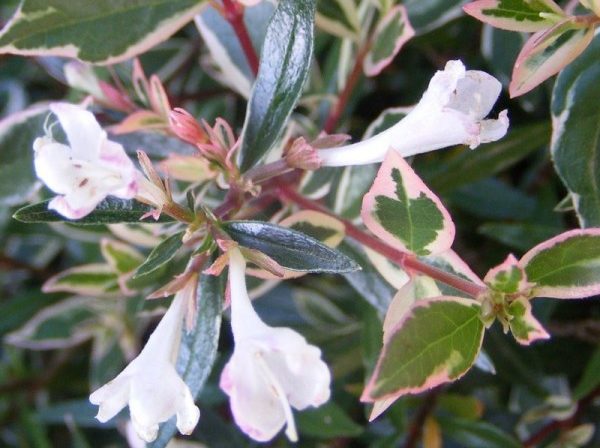

This type of plant has an individual aroma that resembles the smell of lilac, and flowers of a rare lilac or pinkish color and red veins.
Abelia variegated
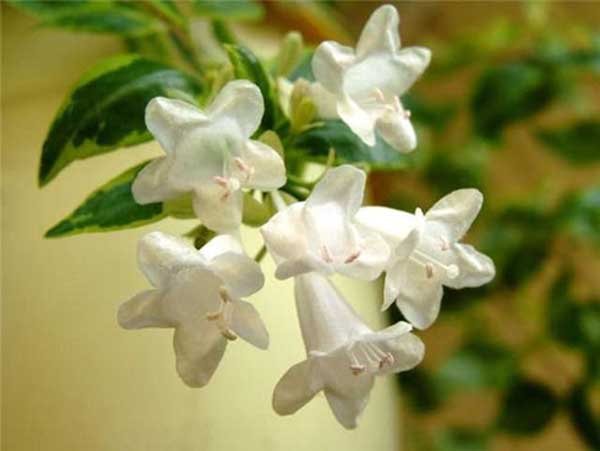

Variegated abelia is a wonderful plant that can decorate both the interior of the house and fill the space in the garden. One of the variants of this type is the abelia kaleidoscope. This is a young variety that was recently created by US scientists. A recognizable feature that the Abelia Kaleidoscope possesses is its compact form. In addition, it is distinguished by its unusual foliage color. They are delicate emerald in the spring, and in the summer and during the winter they become red-golden.
Abelia kaleidoscope
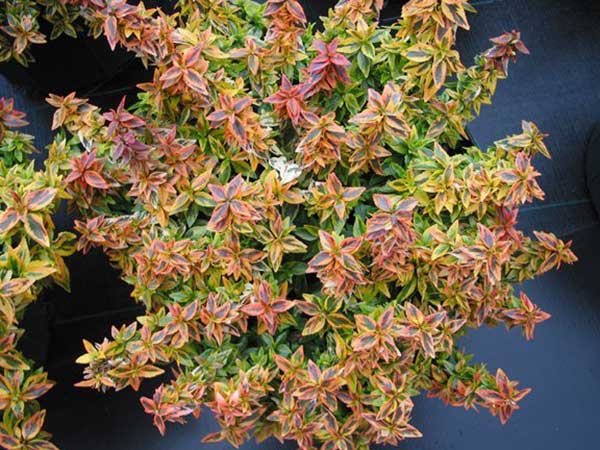

Abelia kaleidoscope blooms for a long time. Flowers cover the bush profusely during the entire flowering time. The flowers are white and pale pink. The plant has reduced branching, so it is easy to keep it in a given form. Due primarily to its decorative qualities, abelia has gained wide recognition among gardeners. Its unpretentiousness makes it possible to grow a plant even for a novice amateur. And most of all for this abelia kaleidoscope is suitable.
How to care for abelia at home
The soil for abelia
Abelia needs a slightly acidic or neutral soil, rich in organic matter, consisting of humus, leafy or sod land and rippers (vermiculite, perlite, sphagnum moss, crushed bark). If it is not possible to prepare the substrate, you can buy ready-made neutral soil in the store and add one of the rippers to it.
Lighting
The brighter and more diffused the lighting, the faster the large-flowered Abelia will bloom on the windowsill. It must be protected from direct rays, and if it is on the southern windowsill, it must be shaded to avoid leaf burns. The best option is the southeast window.On it, the plant will receive enough bright light for successful flowering.
Temperature
Abelia large-flowered does not like drafts and wind, so the windows with her should be opened only in calm weather. Abelia prefers temperatures between 20-25 ºC. In winter, the temperature should be around 14-16 ºC, but not lower, otherwise the plant will shed all the foliage until spring.
Air humidity for abelia
The plant does not require constant humidity, but the plant can be sprayed occasionally. This is especially useful for abelia in the hot season and during the operation of heating devices.
Watering abelia grandiflora
The Abelia plant needs to be watered sparingly, it is very important to monitor the constant maintenance of moisture in the soil, since prolonged drying of the soil can lead to irreversible consequences - the Abelia plant can lose its buds or even die. In summer, the plant is watered more often, in winter - much less often - only after the top layer of the earth has dried.
Top dressing abelia at home
For top dressing, you can use organic and mineral fertilizers, as well as universal fertilizers for flowering plants. Abelia responds very well to fertilizers in the warm season - flowering becomes more abundant. In winter, Abelia does not need feeding.
The soil
For optimal growth, Abelia needs a light, slightly acidic, and also rich in organic matter soil, which will retain water in itself. To compose the soil yourself, you need to take sod or leafy soil, humus and some rippers that retain moisture - vermiculite, sphagnum moss or small bark. If it is not possible to compose such a substrate yourself, you can buy a universal soil for indoor flowering plants with low or close to zero acidity. It is worth remembering that there must be a good drainage layer in the pot. Expanded clay or brick chips are usually used as it.
Planting and caring for abelia (in brief)
- Flowering: from late May to early June to autumn.
- Lighting: bright diffused light with shade from direct sunlight or partial shade.
- Temperature: during the growing season - normal for a dwelling, in winter - 10-15 ºC.
- Watering: from spring to autumn - plentiful, less intense in winter.
- Air humidity: typical for residential premises.
- Top dressing: during the growing season - twice a month with a complex mineral fertilizer or organic solutions. In winter, feeding is not needed.
- Rest period: October to March.
- Transplant: at a young age - twice a season, in a mature age - once every 2-3 years.
- Substrate: from equal parts of leaf and sod land, peat, humus and sand.
- Reproduction: seeds and cuttings.
- Pests: thrips, aphids, spider mites, mealybugs and scale insects.
- Diseases: with waterlogged soil - root rot.
Read more about the cultivation of Abelia below.
Abelia care
As mentioned above, the bush is unpretentious to growing conditions, and the composition of the soil has no peculiarities, but again the standard must be adhered to. Abelia reacts positively to slightly increased acidity in the soil, but not an overabundance. The soil in the pot should be well-drained. There are, of course, some varieties when the plant feels great in the heavy clay composition of the soil, but it is worth adhering to the recommendations. The best option would be a mixture: peat + turf mixture + foliage + humus and sand. A slightly acidic pH can be maintained by adding a small amount of chopped pine bark and needles.
Relative to the temperature of the content in room conditions. During the summer period, the temperature should be up to +20 degrees. In winter, the thermometer should drop to +14, not lower. If wintering is a little warmer, this will not adversely affect the plant.
Necessary lighting. We have already mentioned Abelia's addiction to a lot of sunlight.There is, of course, the option of growing in partial shade, but it is better to stick to the needs of the plant itself. No direct rays, detrimental to the development of the plant, especially during the daytime during spring and summer.
How and with what to properly feed the room Abelia? Top dressing must be done twice a month, in the spring and in the summer season. It is during this period that the most active development takes place.In the period of winter dormancy, it is worth stopping various types of nutrition. It is necessary to give the plant the opportunity to recover its strength for active and healthy development for the next season.
Flowering period of indoor abelia
The duration of active flowering of Abelia is quite a long period, from mid-May to the last decade of November. This is a very positive quality of the plant. A great choice for decorating or simply decorating your room. The bush is able to delight you with excellent, beautiful flowering for almost half a year.
Transfer. Watering. Spraying.
The dry air of the dwelling will not become the reason for the poor development, flowering of this plant. Abelia is perfectly able to do without spraying. The only thing that is necessary is the complete absence of a cold draft, but a sufficiently high-quality airing is very necessary for the flower.
Any indoor plant requires a sufficient amount of moisture. In the spring and summer, watering is necessary more often, but regularly and abundantly. By winter dormancy, gradually reduce the amount of watering and water for one watering. By winter, watering should be very rare. Regular, timely watering is especially necessary for young, actively developing plants. Because the root system of these bushes is actively developing and a sufficient amount of moisture is needed. Already rooted bushes are adapted to mild drought.
Why do you need a transplant into the renewed soil and how to do it correctly? It is recommended to transplant only once a year, in spring, when development is only activated, the plant wakes up after winter dormancy. With an increase in the pot, a rapid growth of the root system of the abelia occurs and the further simple of the bush. The volume of the container fills up very quickly. At the time of transplanting, carefully inspect the roots of the plant, if necessary, trim damaged or more sluggish roots. The container should have good drainage holes. With the growth of the plant, the volume of the pot increases annually.
Home Abelia care
Lighting.
Abelia needs bright lighting, but without direct sunlight on the plant. The optimal position of the plant is windows in the west and east.
Temperature.
To grow abelia at home, the temperature in winter should be at least 10 ° C, but preferably not higher than 15 ° C. If the temperature drops below the permissible value, the abelia can shed the leaves.
Watering abelia.
Abundant watering is necessary from spring to autumn. At the same time, you can spray the plant. In winter, watering is reduced, carefully making sure that the soil does not dry out.
Top dressing abelia.
In spring, summer and autumn, Abelia must be fed 2 times a month with organic and mineral fertilizers suitable for indoor plants. Concentration is normal.
Pruning abelia.
Indoor abelia grows rather quickly and can almost double in the spring-summer period. To create a lush crown, the plant must be pruned, preferably at the end of winter. Shoots are cut in half. If you do not prune, then the plant can be grown as ampelous.
Abelia transplant.
Since indoor abelia grows quite quickly, young plants need to be reloaded 2 times per summer. If the plants grow in tubs, then they need to be transplanted at least once every 2-3 years. Abelia is transplanted into a soil mixture of equal parts of humus, sand, peat, leaf and sod land.
Abelia from seed.
When abelia is propagated by seeds, they are sown in January.Abelia rises very quickly and can bloom in the same year.
Propagation of abelia by cuttings.
Propagate abelia by the shoots remaining after pruning the plant or stem stalks from the top of the bush. For faster rooting of cuttings, they need to be placed in a mixture of peat, sand and perlite, and the temperature should be kept at 25 ° C. Plants grown from cuttings can produce flowers in the same year.
[collapse]
Abelia - varieties
The bush blooms in shades of white and pink, it all depends on the variety. But not only the beauty and aromas of the flower are captivated by Abelia, for each region there is a bush. We will have to take into account the fact that not all varieties are suitable for home cultivation. Some representatives of this species will decorate winter gardens and warm balconies, others will quite successfully spend the winter outdoors.
Abelia variegated
The variegated form is rightfully considered one of the favorites among gardeners. The Abelia shrub of this form is gentle, therefore it is grown mainly in winter gardens. In the open area in front of the house, the bush can be found in the warm summer. The tenderness of the shrub is manifested not only in its sensitivity to ambient temperature, but also in its decorative qualities. Variegated variety "Kaleidoscope" is popular with professionals and beginners.


Abelia korean
From the expanses of Korea and Russia, an indoor Abelia flower with especially fragrant flowers came to gardeners' plots. The peculiarity of the bush in its height is about six meters, the shoots can reach this length under the right growing conditions:
- you need moist and at the same time well-drained soil;
- shoots will transfer direct rays of the sun without loss, therefore, open areas may well become a place of constant growth;
- Abelia grows on the shoots of last year, therefore, annual pruning after flowering is a prerequisite for active growth and budding;
- this form is considered the most winter-hardy among all representatives;
- another feature of the bush is the change in the shade of the foliage in the fall from dark green to bright red-orange.


Abelia chinese
According to the description of this form of abelia, it is a drooping shrub with a characteristic color of foliage and shoots. The dark shade of green leaves looks good on the red background of the shoots. After opening, the flowers are no less pleasant to the eye: their shape resembles bells, collected in bunches of several inflorescences. The bush begins to bloom in mid-summer, and sheds inflorescences around mid-autumn.


Abelia grandiflora
From the description it follows that this Abelia is a hybrid created by crossing the Chinese and one-flowered forms. The bush feels quite comfortable both indoors and outdoors. If you provide it with the required warm temperature, it does not drop foliage all year round. The bush can be called compact, it grows up to two meters. A special charm is given by young drooping shoots of a delicate pink color. It will delight you with flowers abundantly from early summer to mid-autumn. In room conditions, it grows up to a meter.
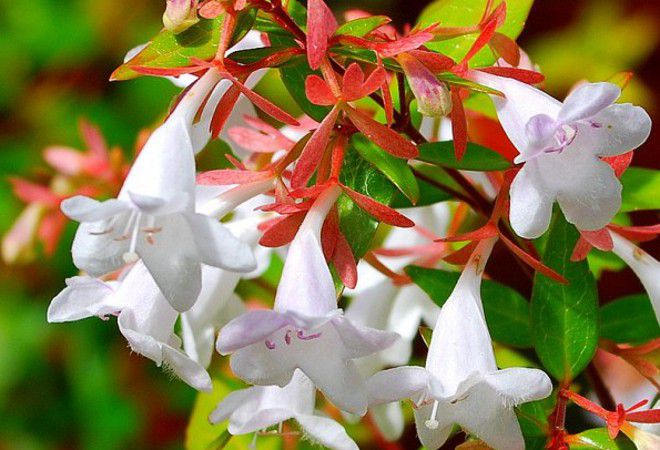

Abelia Mosanskaya
If you need to pick up varieties of Abelia as a room crop, the Mosan form is not the best choice. The bush blooms very fragrant, indoors it will interfere. But for a winter garden or a personal plot it is ideal. The plant loves warmth and for cold regions it is permissible to grow it only indoors, only the Korean Mosan Abelia is able to overwinter outdoors. But drought is not terrible for the roots. Acidic soil, good drainage and proper watering will help unleash the plant's full potential.
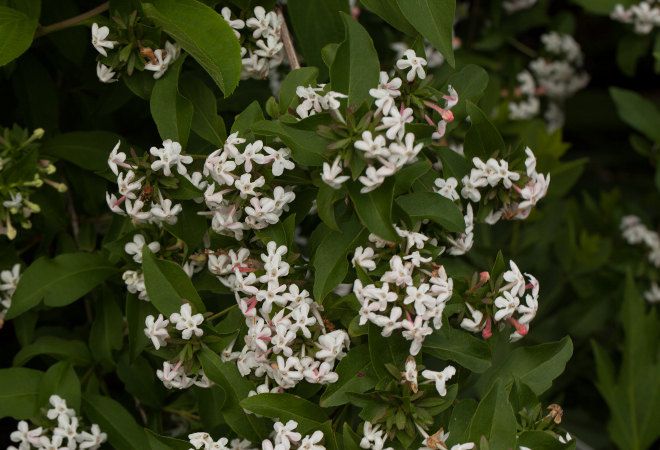

Abelia floribunda
Among all varieties and forms, homemade abelia is distinguished by abundant flowering. It is an evergreen shrub with spectacular drooping shoots. If the other varieties delight the eye with a change in foliage shades in the fall, then this bush will immediately surprise you with a bright pink bloom. The buds open in May and for several months the shoots are covered with delicate or rich bright pink flowers.Against the background of dark glossy foliage, the buds look elegant. The effect enhances the red color of the shoots. The aroma of flowers is not saturated.


Growing conditions
When choosing a place to place this shrub, one should take into account what conditions are necessary for its optimal development. Plants in containers or pots are best placed in a conservatory or greenhouse for the winter. The shrub can also overwinter outdoors when the winter is mild enough. Well covered in autumn, it easily tolerates temperatures up to 9 ° C below zero. If it happens that the frost picks up branches, in the spring these damaged shoots are removed. The most suitable temperature regime for this plant in winter is from 10 to 15 ⁰С.
Abelia large-flowered prefers to grow in areas well-lit by the sun. But it must be protected from the scorching rays of the day. They can dry out the plant and cause leaf burns. Sunlight is most suitable in the morning and evening hours. In shaded areas, this plant practically does not develop. Its growth is too slow, there is no flowering, and the leaves gradually turn pale, becoming almost yellow.
Light, slightly acidic soils with a pH of 6.0-6.5 are preferred. They must be rich in organic matter.
Reproduction and possible pests of large-flowered abelia
Reproduction of abelia is carried out in several ways:
- Seeds.
- Green cuttings.
- Lignified cuttings.
It is important to undo that even stimulants do not help to increase rooting, which is extremely low. The shrub has developed root growth, thickened clumps.
Most often, root shoots are planted for reproduction of Abelia. Each sprout can form a new shrub. A large number of them are formed over the season, so there is a chance that some of them will take root.
At the end of summer, after that it lands in a permanent place. The air temperature should not be below 20 degrees. You can try to propagate cuttings, for this they are placed in a light substrate, for example, perlite, peat or sand and kept at a temperature of 20-25 degrees until rooting. In the same season, with a successful scenario, you can get a small bush that will bloom.
The most common bush destroyers are:
- Thrips
- Shield
- Spider mite
It is not always easy to propagate a plant, but it will thank you with flowering already this year. Depending on the type of abelia, you can get a shrub or woody plant. The plant will bring a minimum of hassle and maximum pleasure.
More information can be found in the video.
One of the many types of ornamental shrubs is large-flowered abelia. This plant is very common among gardeners due to its unpretentiousness and long flowering, which lasts from June to September.
1. Seven Secrets of Success:
| 1. Growing temperature: summer - 20 - 25 ° С, winter - 10 - 14 ° С. |
| 2. Lighting: Shade from direct sunlight. |
| 3. Watering and humidity: a well-moistened substrate during the growing season, in winter in accordance with the room temperature, the air humidity increases with the onset of hot weather or when the central heating is on. |
| 4. Pruning: mostly sanitary, in spring. Caring for abelia at home is not difficult. |
| 5. The soil: must have an acidic pH. |
| 6. Top dressing: during the entire growing season - mineral fertilizers or organic matter. |
| 7. Reproduction: stem cuttings in spring and summer, sometimes grown from seed abelia. |
Botanical name: Abelia
Abelia shrub - family... Honeysuckle.
Origin... Southeast Asia, Korea, China, grows on open rocky slopes.
Description
Semi-evergreen shrub, sometimes growing up to 180 cm in height, is the most popular in Europe. In the northern regions of Russia, it is mainly bred only as a pot culture.Glossy shiny leaves of a dark green color have an oblong shape and a pointed tip. They are located oppositely on the shoot.
During flowering, the large-flowered abelia, the photo of which is posted in this article, emits a very pleasant aroma that attracts pollinating insects. Flowers adorn the bush with lush bunches. They cover the plant almost all summer and are mainly concentrated at the ends of the branches. Each cluster is composed of many large, five-petalled flowers that range in color from white to purple, depending on the cultivar. Each of them resembles a bell in its shape. Small fruits contain only one seed.
The most common varieties for which the large-flowered abelia shrub is known are kaleidoskope, edward goucher, francis mason, distinguished by its yellow leaves.
4.Types of abelia:
4.1 Abelia Shumann - Abelia shumannii
Shrub about 2 m tall with pink-lilac tubular flowers, begins to bloom in June and blooms until October. The buds of this shrub are mesmerizing with a strong and pleasant scent. This abelia has small, leathery and single-seeded fruits.
↑ Up,
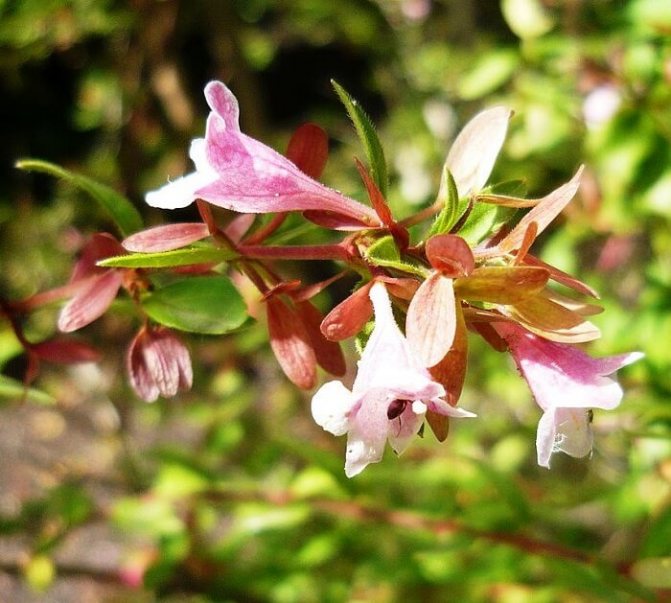

Photo: Sten Porse
4.2 Abelia large-flowered or grandiflora - Abelia x grandiflora
Abelia large-flowered is a round, outstretched, multi-stemmed shrub with gracefully curved branches. Leaves are opposite, ovoid, shiny, dark green, on a short petiole, or even without it. The flowers are fragrant, white-pink bell-shaped or tubular, quite numerous, continuous flowering from May to September. Shrub height up to 180 cm. Inflorescence - apical panicle of white, funnel-shaped, fragrant flowers located at the ends of branches, blooms profusely.
↑ Up,
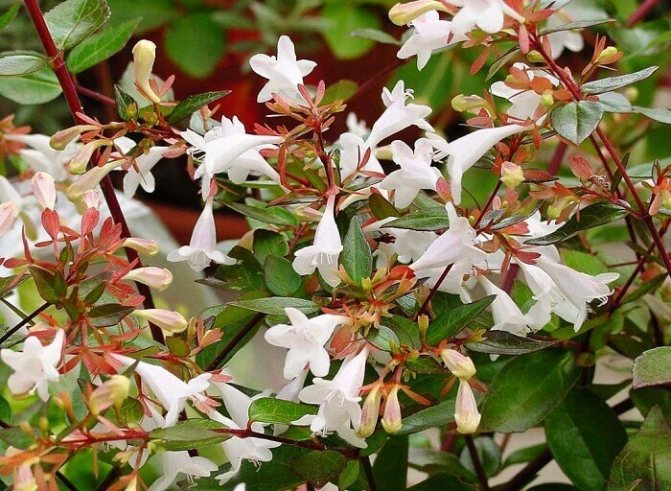

Photo: Wouter Hagens
4.3 Korean Abelia - Abelia coreana
It grows on rocky slopes, rocks, among bushes, in the forests of the Russian Far East (southern part), northwestern China and Korea. Shrub a. Korean grows slowly and reaches a height of 1 to 2.5 meters, has elongated ovate or lanceolate leaves 2.5 - 6.5 cm long and 1 - 3.5 cm wide. The flowers are tubular, rather small - about 2 cm. It blooms in June for three weeks to a month.
↑ Up,
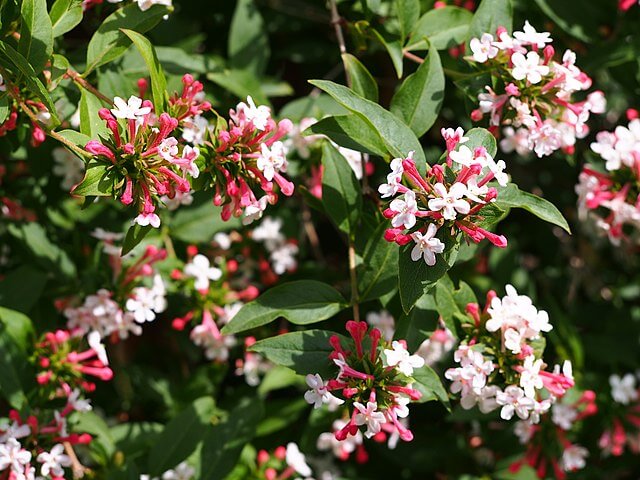

Photo: leoleobobeo
4.4. Chinese Abelia - Abelia chinensis
An attractive, multi-stemmed, deciduous shrub with very abundant and long flowering - starting in July, flowering can last until September. Young shoots can have short, but very dense pubescence. The leaves are green, ovoid, leafy blades with small denticles along the edge. The flowers are white, very fragrant, tubular, with pink bracts, collected in inflorescences - umbrellas. The flowering is so profuse that the stems can bend under the weight of the buds.
↑ Up,


4.5. Abelia "Kaleidoscope" - Abelia "Kaleidoscope"
This variety was recently bred and belongs to the large-flowered type. A distinctive feature of this species is the extremely varied color of the foliage - young spring leaves have a light green hue, over time they darken a little, and in summer they become golden yellow. In the fall, the plant adorns itself with a bright purple outfit. The center of the leaf blade is usually colored dark - for example, brown. The flowers are large, fragrant, white or slightly pinkish.
↑ Up,
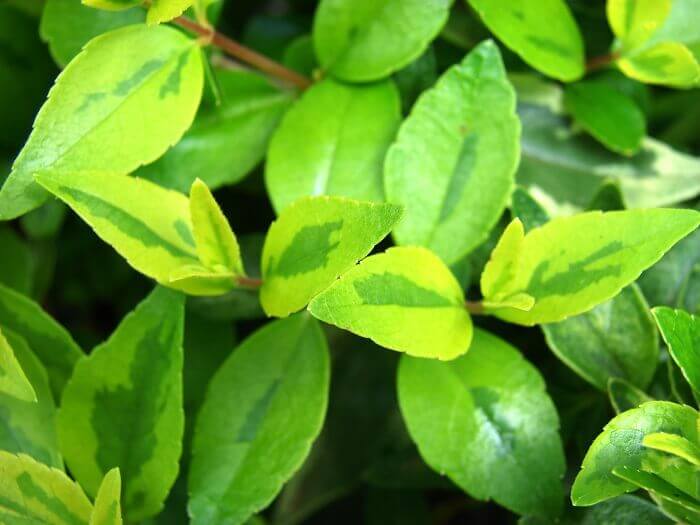

4.6. Abelia corymbose - Abelia corumbosa
A small shrub with a lush rounded crown, formed by many thin and flexible shoots. The leaves are dark green, tough, leafy blades with small denticles along the edge. The flowers are white or pink, tubular, with 5 rounded petals, fragrant, collected in large inflorescences - shields.
↑ Up,
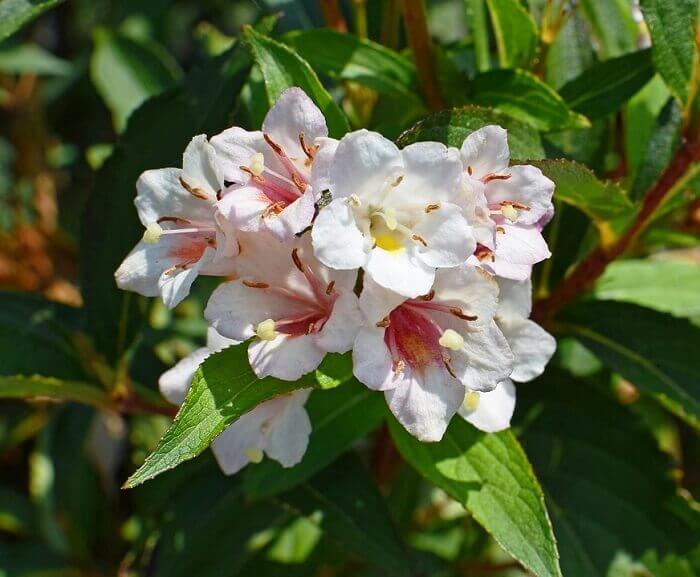

4.7 Abelia "Edward Goucher"
The shrub is distinguished by a very long flowering period and color of the buds - they can be pink and even burgundy. Young leaves that appear on the tops of the stems are copper-brown, while adults have a dark green color, which changes to a bronze tint in autumn.
↑ Up,
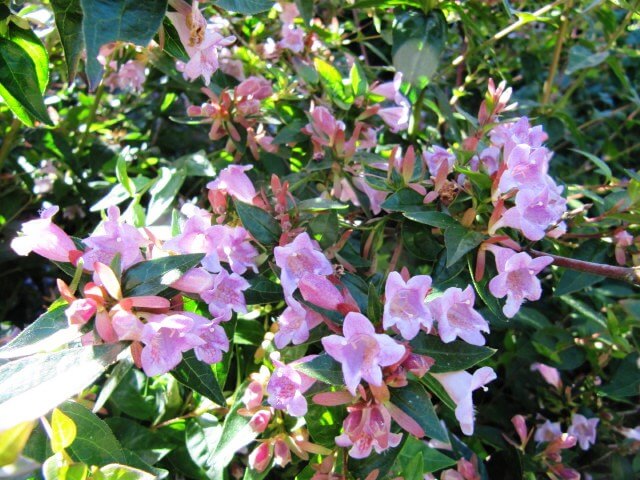

Varieties of Abelia with a photo
Large-flowered. The most common hybrid species, distinguished by evergreen shrubs, reaching a size of 1.5 to 2 meters. Long shoots, flat small leaves, large racemose inflorescences of snow-white color adorn the plant.
Flowering lasts a long time, is abundant and is accompanied by a rich fragrant aroma. This plant variety is obtained by crossing two varieties of culture. It is possible to grow Large-flowered Abelia only in the southern regions of the country, since the plant can withstand temperatures of at least twelve degrees with a minus.
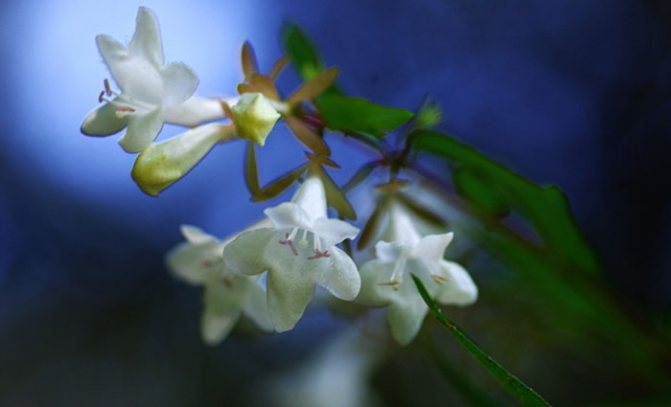

Abelia Large-flowered
Blooming profusely. This species fully justifies its name with large flowers reaching up to four centimeters. They look like long pink funnels and glow against a green backdrop of smooth, rich foliage. Flowering begins in late spring or early summer and lasts for several months.
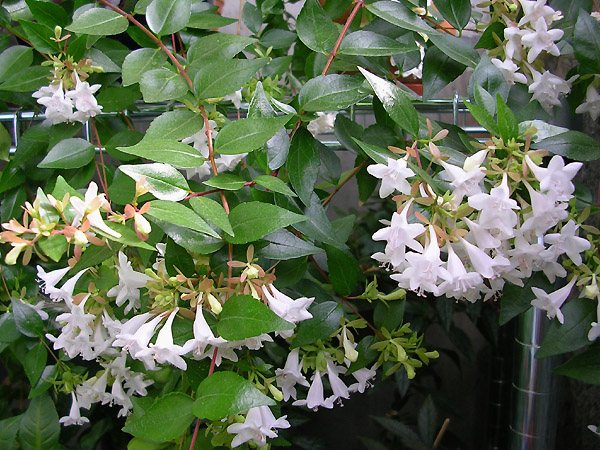

Abelia blooming profusely
Chinese. This is a semi-evergreen shrub of two meters in height. The leaf plates have the shape of an oval pointed at the end. The plant is decorated with white flowers with red markings growing in the form of bells.
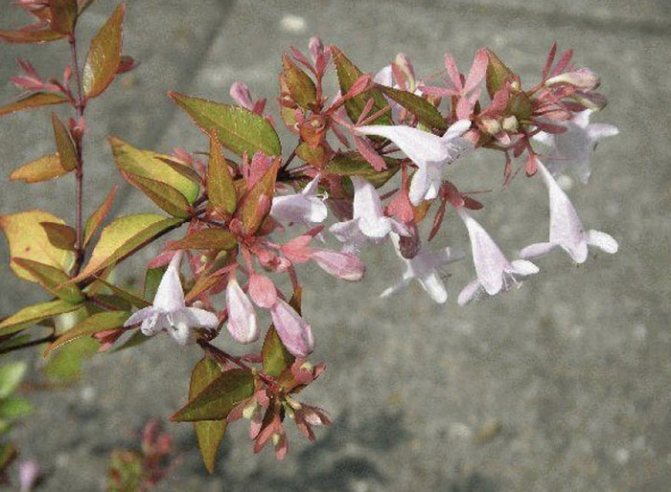

Abelia chinese
Edward Gaucher. Of all the varieties of Abelia, the hybrid stands out for its very colorful inflorescences that look like a funnel with a light lilac base, pink petals and a bright red bracts. The plant blooms in comfortable conditions throughout the year and emits an aroma similar to the smell of lilac.


Abelia Edward Gaucher
Kaleidoscope. This is the most recent hybrid variety bred. The plant is distinguished by an unconventional color and shape of foliage, the plates of which, with the onset of spring, are painted with the color of an emerald with light shades in the center. The edging of the leaves during this period of time is yellow in color, in summer it changes and becomes golden-red. In autumn and winter, it acquires fiery tones.
Buds of inflorescences of red-pink color. After opening, the flowers are snow-white, bloom profusely for a long time and constantly emit a scent of freshness. Shoots do not grow in length, and this property allows the Kaleidoscope to maintain symmetrical compact forms.
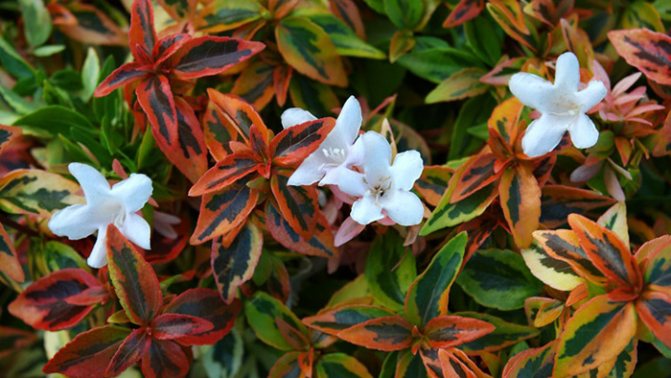

Abelia Kaleidoscope
Korean. The shrub does not grow very quickly. An adult plant grows up to two and a half meters in size. The crown, usually thickened and compacted, the branches stretch diagonally upwards, and subsequently hang to the ground. The foliage is pointed at the ends, in autumn it turns from green to orange-red.
The flowers are small, white-pink, in the form of tubules, the edges of which are bent in different directions. Flowering begins in late spring and continues until mid-autumn. The smell of flowers is sharp, very fragrant, the plant is an excellent honey plant.
It lends itself well to cutting and makes it possible to give the bush all kinds of shapes. This crop variety has the longest flowering time when compared with other flowering shrubs.
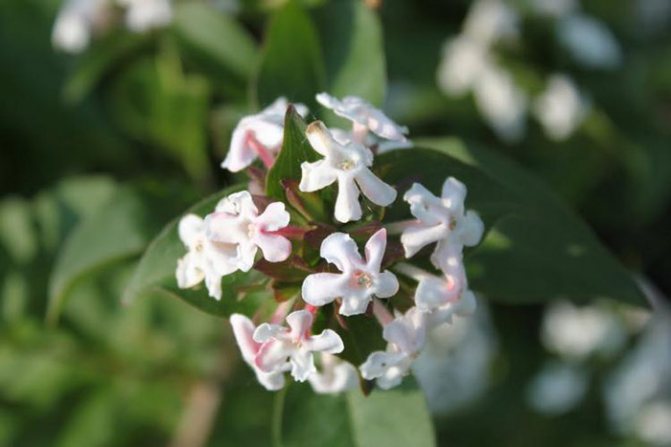

Abelia Korean
Abelia flower - description
At the moment, Abelia has more than 30 varieties and species. The plant, depending on the species, can be either a miniature tree or a spreading shrub. Such trees and shrubs, in turn, are divided into evergreen, deciduous and semi-deciduous. The plant has glossy leaves, usually dark green in color. They are located opposite each other. Abelia has a very fragrant flowering - it usually blooms 3-4 months a year with tubular flowers of lilac, pink or white.
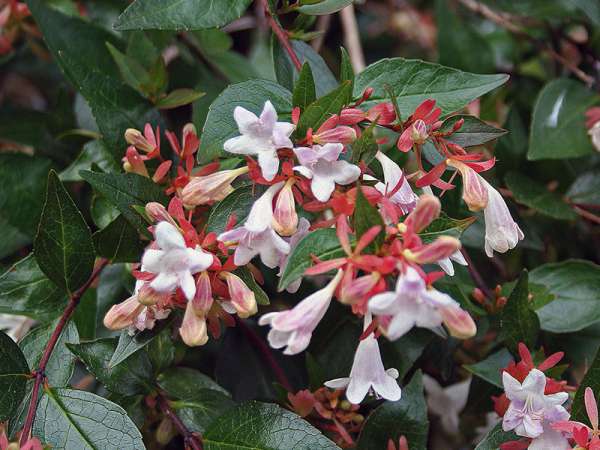

Despite the fact that Abelia has many varieties and species, only one hybrid species is grown at home - Abelia grandiflora (Abelia grandiflora). This abelia blooms with lilac-pink flowers. Caring for this plant is not difficult, and, observing all the rules, you can grow a very beautiful bush that delights with flowering.
Plant care in the garden and at home
Abelia can be grown both in the garden and indoors. Caring for them is slightly different, but has common features. The main condition that will ensure active growth and development of the flower is correct lighting. it should not be exposed to direct sunlight, the light should be diffused.The plant will develop in direct sunlight, but most likely it will not bloom, since this is detrimental to the petals.
The plant is located on the southeast or south side. The room should have light curtains on the windows. The ambient temperature is also important for the plant. Abelia does not like heat, so 22 degrees are enough for her in summer, and 10-15 degrees in winter. In a greenhouse or room, the temperature starts to drop in October.
The plant is difficult to tolerate winds and drafts, this should be taken into account when choosing a permanent place. Even the summer wind is harmful.
Abelia loves moisture, this applies not only to abundant watering, but also to air humidity.
If possible, the leaves should be sprayed, especially during dry periods. The pot is selected large, the substrate is mixed.
You can prepare the soil yourself using the following ingredients: 1 part sand plus 2 parts humus plus 2 parts peat soil plus 2 parts turf soil.
Plant care secrets:
- Abundant watering is provided in spring and summer, during the rest of the year watering is reduced to moderate. Even in winter, the soil should not be allowed to dry out.
- The shrub is good for fertilization. , you can use a universal fertilizer for indoor plants, you can alternate mineral and organic fertilizers. They are brought in 2 times a month, in autumn and winter this is not required.
- Since the plant is actively growing, at a young age it is transplanted annually. Do not forget about pruning, it is done when the last flower fades. Pruning is needed for the splendor of the shoots.
- Good drainage is provided for an outdoor plant, the soil should be rich. It is also important to protect the plant from direct sunlight and water in a timely manner.
- After flowering, pruning is done.
Botanical description
Abelia is an evergreen or deciduous shrub (depending on the type of plant), the height of which is 1.5-2 meters and the same diameter. There are wild specimens, the height of which can reach 5-6 meters. The shrub belongs to the Honeysuckle family, and, accordingly, its flowers have a very powerful aroma.
Abelia leaves are saturated green, glossy, almond-shaped, arranged in pairs. The flowers of the plant are bell-shaped and tubular, consist of 5 petals of white or pink shades, and have a bright aroma.
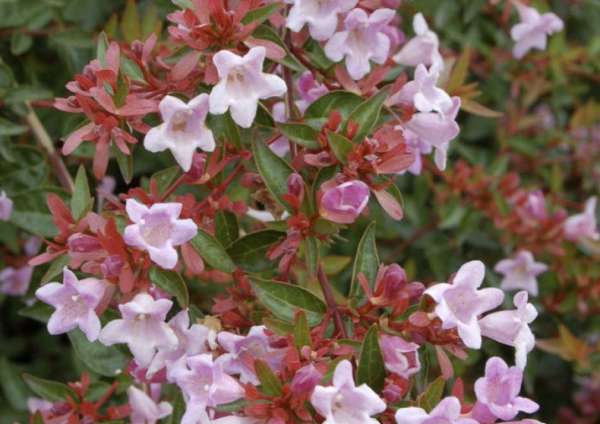

The genus Abelia includes at least 15 plant species and their hybrid descendants, but not all varieties are suitable for garden cultivation, the bulk of varieties are intended for greenhouse cultivation. Nevertheless, consider the most popular types of this shrub among gardeners:
- abelia grandiflorum, she is grandiflora, is one of the largest representatives of this plant. The shrub can reach a height of 6 meters. This species is a hybrid of Chinese and one-flowered abelia, which accounts for its impressive size. The flowers of the plant are funnel-shaped, white, pink, lilac, collected in inflorescences and are located along the entire length of the shoots, but most are concentrated at the end of the branch, have a strong sweet aroma. Like many hybrid plants, it is unpretentious in care and has a long flowering period: from June to the end of September, which makes it the most common in garden plots;


- abelia chinese is a medium-sized bush, not exceeding 2 meters, has dense green oval pointed leaves and white fragrant flowers in red sepals with red grooves. It blooms from May-June to the end of September, it is considered a semi-evergreen shrub, because after the flowers fall, the foliage is preserved, which changes color from green to bronze;


- abelia korean - this is the most persistent and hardy type of shrub, it is frost-resistant.Flowering lasts from spring to late autumn, after its completion, red-orange leaves remain. The flowers are usually white or white-pink, have a very bright and strong odor compared to other brethren;
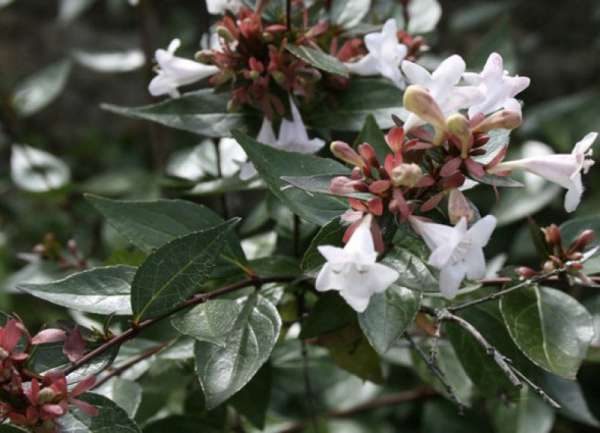

- abelia variegated it is a favorite among flower growers, because it grows well both at home and in garden conditions. It blooms with white bells with a honey aroma. The most common variety of variegated abelia with the romantic name "Kaleidoscope", its distinctive feature is foliage: in spring and summer it retains its usual green color, and in autumn it becomes variegated, yellow-red.


Abelia: growing and care - Indasad
Abelia is an ornamental flowering shrub that owes its name to the English physician Clark Abel. Abelia's abundant and long flowering, rapid growth, gently curved branches and a pleasant aroma of flowers have made Abelia widespread as an ornamental plant.
The genus Abelia belongs to the Linnaean family, has about 30 species, includes evergreen and deciduous shrubs or small trees. The homeland of the plant is Southeast Asia.
Abelia leaves are dark green, shiny, oval-lanceolate, 3 - 6 cm in size, pointed at the edges. Located opposite along the entire length of the branch. The flowers are white or pinkish and have a strong and pleasant aroma. Usually small, reaching a maximum diameter of 5 cm. In shape, the flowers are oblong, resembling tubules collected from petals with bent ends, grouped in bunches at the ends of branches or located in the axils of leaves. The fruits of the plant are small, leathery, oblong or curved in shape, contain one seed.
Growing in natural conditions, Abelia can reach 3-4 meters in height.
The flowering period is long, lasting from spring to early autumn, depending on the type of plant.
The most common types of abelia:
Abelia large-flowered (Abelia x grandiflora) - a hybrid of Abelia Chinese and Abelia one-flowered; reaches a height of 2 m, strongly branching stems. Abelia floribunda is a semi-leafy shrub plant up to 1 meter tall. Abelia triflora (Abelia triflora) is an evergreen shrub up to 4 m high with beautiful large leaves and spectacular flowers, collected in bunches; very hardy species, tolerates drought and low temperatures well.
Growing abelia
The shrub is planted in autumn or early spring. The soil should be rich, well-drained, containing a sufficient amount of mineral salts. Only young plants need watering. Rooted bushes should be provided with moderate moisture only during drought periods. Abelia loves well-lit areas, so when choosing a site for planting, a sufficient amount of sunlight is the determining factor. During the growing season and on very hot days, it is advisable for the plant to provide shading.
When planting, it should be borne in mind that the plant is quite thermophilic. The optimum temperature range is 20 - 22 ° C.
Abelia does not require complicated care. It grows very quickly, so it needs constant pruning to give it a correct and beautiful shape. After flowering, damaged and old shoots should be removed.
There is no need to shelter Abelia for the winter. But it should be borne in mind that the plant does not tolerate drafts well. To prolong the duration and abundance of flowering, the planting area must be protected from the wind.
Abelia pests
Of the pests, the greatest damage is caused by aphids, covering the leaves with sugary secretions, on which the black develops. Insects should be controlled with appropriate insecticidal preparations.
Reproduction of abelia
It is best to propagate the abelia by root shoots, which are formed in abundance annually.Each sprout can grow a separate plant, which at the end of summer is transplanted to a permanent place of growth, while the temperature should be at least 20 ° C. Other methods of propagation: seeds and cuttings, can cause certain difficulties due to poor rooting.
Abelia in landscape design
In gardens and parks, Abelia is usually grown outdoors. It looks good both as a single plant and in group plantings. The popularity of the shrub is also explained by the fact that it retains its decorative effect even after prolonged flowering - purple sepals remain on the peduncle.
Abelia is ideal for landscaping a garden area. Beautiful fragrant flowers serve as a wonderful long-flowering live decoration. In the shade of the dense foliage of this shrub, you can equip a place to rest. Abelia tolerates strong pruning, so it can serve as an original hedge. Looks great next to the gazebo, used to create landscape details. During flowering, the branches, weighted with flowers, gracefully bend downward, which allows the plant to be used as an ampelous plant. Such characteristics have provided abelia with a well-deserved popularity among decorative cultures, and it is widely represented in landscape gardening architecture.
Varieties and types
It can be up to two meters high. It has drooping branches, the foliage is rounded-pointed, the bell-shaped flowers are painted white with splashes of scarlet.
This species is a hybrid derived from Abelia Chinese and Monoflower. It reaches almost two meters and can be grown in rooms, but it grows lower. White flowers, collected in inflorescences, have a pleasant smell.
A fairly tall shrub with oval foliage with a dusty edge. Flowers are solitary, funnel-shaped.
Also sometimes there are species grandiflora
and
abelia lush
, but due to the climate we mainly grow
abelia korean
.
Pests
Among pests, special harm can be caused by:
- Aphid
... If the leaves of the plant curl, and the tips of the shoots are sticky and die off, this means that the plant has been affected by aphids. In this case, it is necessary to wash the shoots with soap, treat with an insecticide. - Spider mite
... If the leaves are in light dots, they die off and a thin cobweb is visible on them - this is the work of a spider mite. Rinse the plant with cool water as often as possible. Of the preparations, you can use fitoverm, neoron, sulfur. - Thrips.
Leaves with yellow dots, die off, and black dots on the bottom of the leaf, then this is a defeat by thrips. In the fight against them, special tapes are used - traps. You can spray the plant with an insecticide (fitoverm, actellik). If necessary, the procedure can be carried out repeatedly.
A mature plant will be very large and take up quite a bit of space. The flower is also grown as an ampelous one, then it will take up much less space.
The number of plant varieties that can successfully decorate the interiors of apartments and offices is hundreds and thousands of species.
Many of them are widespread, some are only making their way to popular recognition. One such beautiful stranger will be discussed in this article. The Abelia plant, which belongs to the Honeysuckle family, is named after the British physician Abel Clarke. This cold-resistant plant originates in the highlands of China and Japan, as well as India and Mexico. The Abelia flower is able to attract with its appearance throughout the year, and therefore has earned the great love of many gardeners.
Possible problems
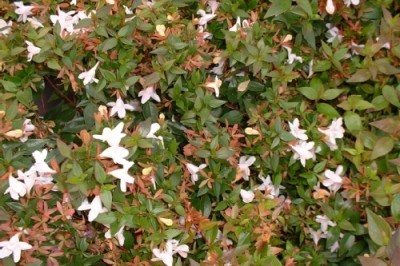

The plant does not bloom, its foliage turns pale - lack of lighting. You need to move the container to a lighter place.
Leaves turn yellow and dry starting from the tips - insufficient moisture of the soil and / or air.
It is necessary to optimize the mode of watering and spraying.
Drying brown patches form on the leaves in summer. - sunburn. Abelia needs to be shaded.
Reproduction methods
Abelia is propagated by seeds and cuttings.
In spring, green cuttings five centimeters long are planted in wet sand. After about three weeks, the cuttings will take root and after a while they will turn into a small bush. The flower will bloom in the same season.
If the plant is propagated by seeds, they are scattered over the soil surface and sprinkled with a layer of sand. During the season, the sprouts are transplanted three times in a larger container.
Seedlings should be sprayed and aired with great care.
Abelia - Deciduous trees and shrubs - Ornamental trees and shrubs
|
Abelia (Abelia) belongs to the family of honeysuckle (Caprifoliaceae) and is named after the English physician Clark Abel (C. Abel, 1780-1826). These deciduous and evergreen shrubs with opposite leaves and pairs of axillary flowers belong to ornamental plants due to their abundant flowering. Delicate flowers with a tubular or bell-shaped corolla have a pleasant scent. The genus includes about 30 species, most of which grow in Southeast Asia, less often in America.
|
|
Abelia Korean (Abelia coreana) naturally grows in mixed forests and on rocky slopes in Russia (Primorsky Krai), Northeastern China and North Korea. Densely branched shrub up to 2 m high with a broad-ovate crown and brown shoots densely covered with oblong-ovate leaves 3-6 cm long. The leaf blade is pubescent from above, closer to the apex, the edge is large-crowned or serrate, with cilia. In June, small, about 1 cm long, fragrant flowers bloom, which do not fade for a long time. Pale pink 4-lobed corolla 15 mm long becomes white when flowering. The calyx is green, narrow tubular, has 4 large bent lobes up to 12 mm long, which persist for a long time with fruits, acquiring a reddish tint. In September, oblong leathery capsules 1 cm long with 4 longitudinal ribs ripen. They contain small oblong seeds. The species is cultivated in botanical gardens. The shrub is not very capricious, it can withstand winters in Central Russia without shelter.
|
|
Abelia chinese (Abelia chinensis) is native to Central and Eastern China. Deciduous shrub up to 1.5 m high, young shoots are reddish with pubescence. Leaves are ovate, 2-4 cm long, serrate along the edge, with a pointed apex, strongly pubescent below. Fragrant flowers are collected in 2 in the axils of the leaves in short panicles. Corolla is white, funnel-shaped.
Abelia grandiflorum (Abelia grandiflora) is of hybrid origin and comes from Abelia Chinese and one-flowered. It was obtained at the end of the 19th century in a culture in Northern Italy. Semi-evergreen shrub up to 1.5-2 m high has pubescent shoots and ovoid leaves up to 3 cm long. Fragrant flowers with a large white-pink corolla 2 cm long, bell-shaped are especially valuable. Flowers are collected in panicle inflorescences, located at the ends of the shoots. The species is so thermophilic that it can withstand temperature drops only up to -12 ° C, it grows on the Black Sea coast of the Caucasus, the southern coast of Crimea. It freezes out in the open ground in Central Russia, but can be used as a houseplant. Especially dressed up is the Francis Mason variety - a small bush with golden leaves.
Abelia three-flowered (Abelia triflora) is an evergreen shrub (up to 4 m high) native to the Himalayas. Leaves lanceolate to ovate with a broadly wedge-shaped base. Large fragrant flowers up to 3-5 cm in diameter have a spectacular tubular corolla, at first light red, later pink-white. Flowers are collected in 3-flowered inflorescences in the axils of the upper leaves. The species has been known in culture since 1847, grows in the Crimea, but freezes in central Russia.
Abelia blooming (Abelia floribunda) is native to Mexico. Evergreen shrub 1-1.5 m high with reddish pubescent shoots. Leaves are dense, ovate or elliptical, 2-4 cm long.The flowers are fragrant, with funnel-shaped carmine-purple or pink-red 5-lobed corolla, on drooping pedicels. The calyx is 5-membered. The species blooms magnificently and is very decorative, but due to its low winter hardiness, it is cultivated in gardens and parks in southern Russia, in the Krasnodar Territory and in the Crimea.
Growing reviews
All abelias smell, but the smell differs from the variety, although it is very subtle and pleasant for everyone. In pots I already have large bushes and in bloom, a meter in diameter, no less. Abelia (only in the south) should be planted in the ground only from May to early August and very deeply. It is the buried planting that gives further wintering. Additional roots are formed on all buried parts of the svols, in winter the plant measures less, in summer the root heats up less. I don't water it often, but she doesn't mind, even in extreme heat, deep planting again helps out, she gets food for herself.
Anyone who has tried to propagate Abelia knows that it is not so easy. It takes root for a long time. From 10 cuttings 2-3 can be taken. It gives initially thin lifeless roots and here the most important thing is to properly plant and preserve the plant on such roots, and even transfer it to adulthood.
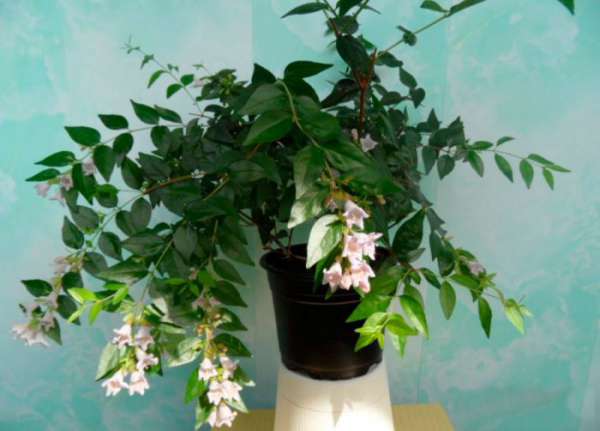

An evergreen plant like abelia (Abelia) is represented as a bush. Moreover, these deciduous bushes are not very high. It belongs to the Linnaeaceae family. In the wild, abelia can be found in Mexico and Southeast Asia. This genus was named in honor of the doctor Clark Abel, who is an Englishman and worked in China in the 19th century.
This flowering shrub has dark green foliage. These shiny leaves are opposite and have short petioles. Fragrant flowers, funnel-shaped or bell-shaped, are located on the apical as well as axillary peduncles. The oblong-shaped flowers consist of petals, the edges of which are slightly bent. They are light pink or white in color. In leathery small fruits that have a curved or oblong shape, there is one seed.
This flower is often grown in greenhouses or used to decorate spacious rooms.

